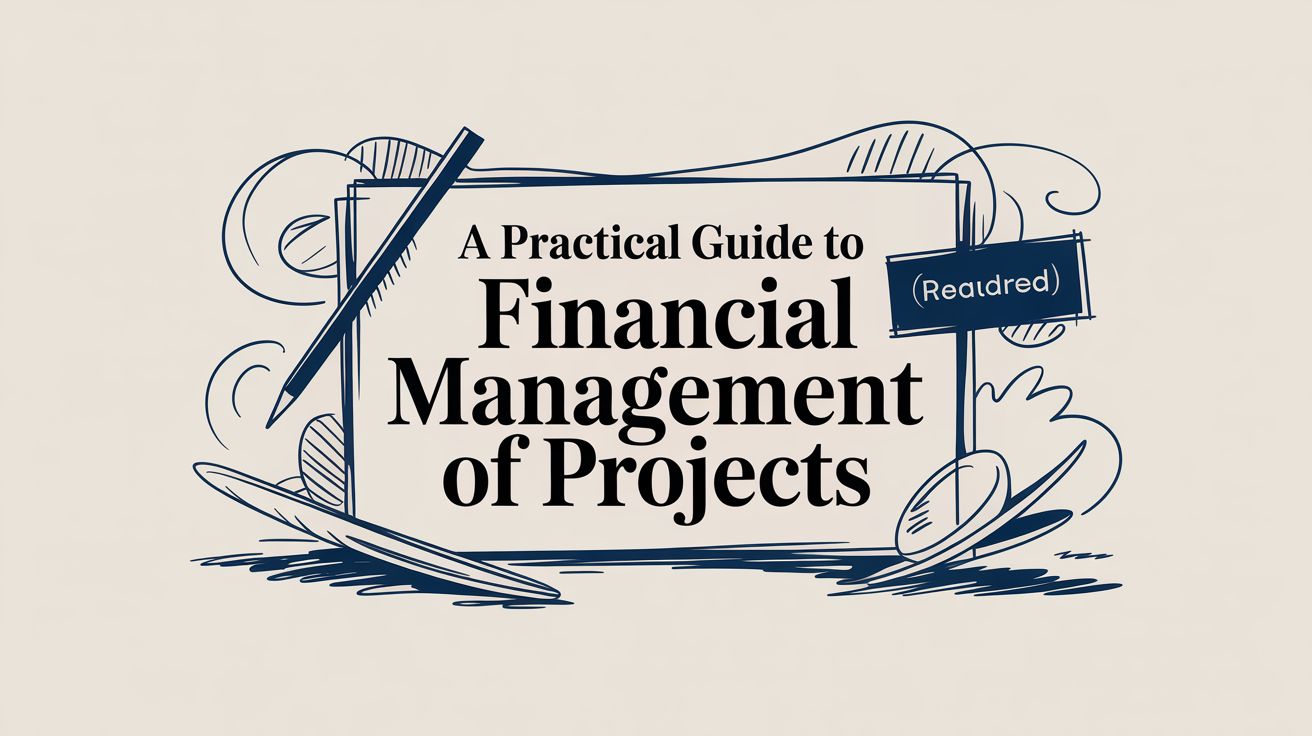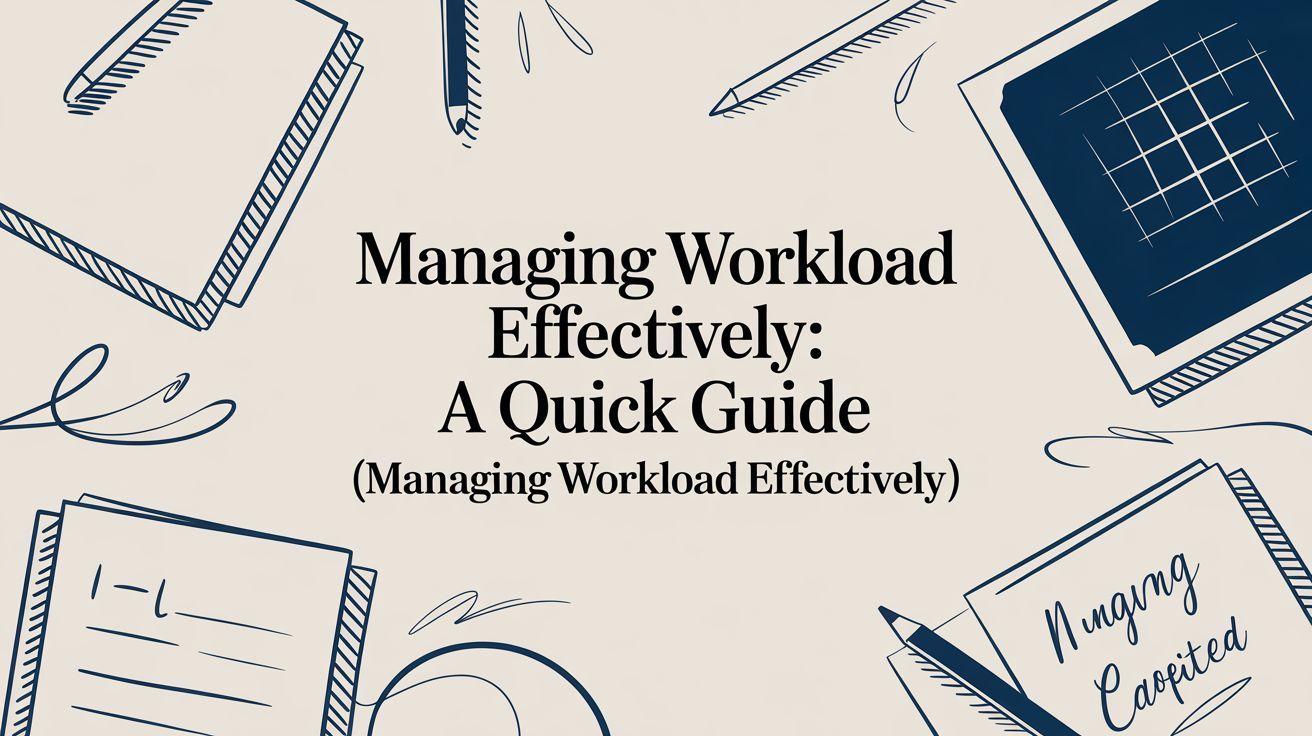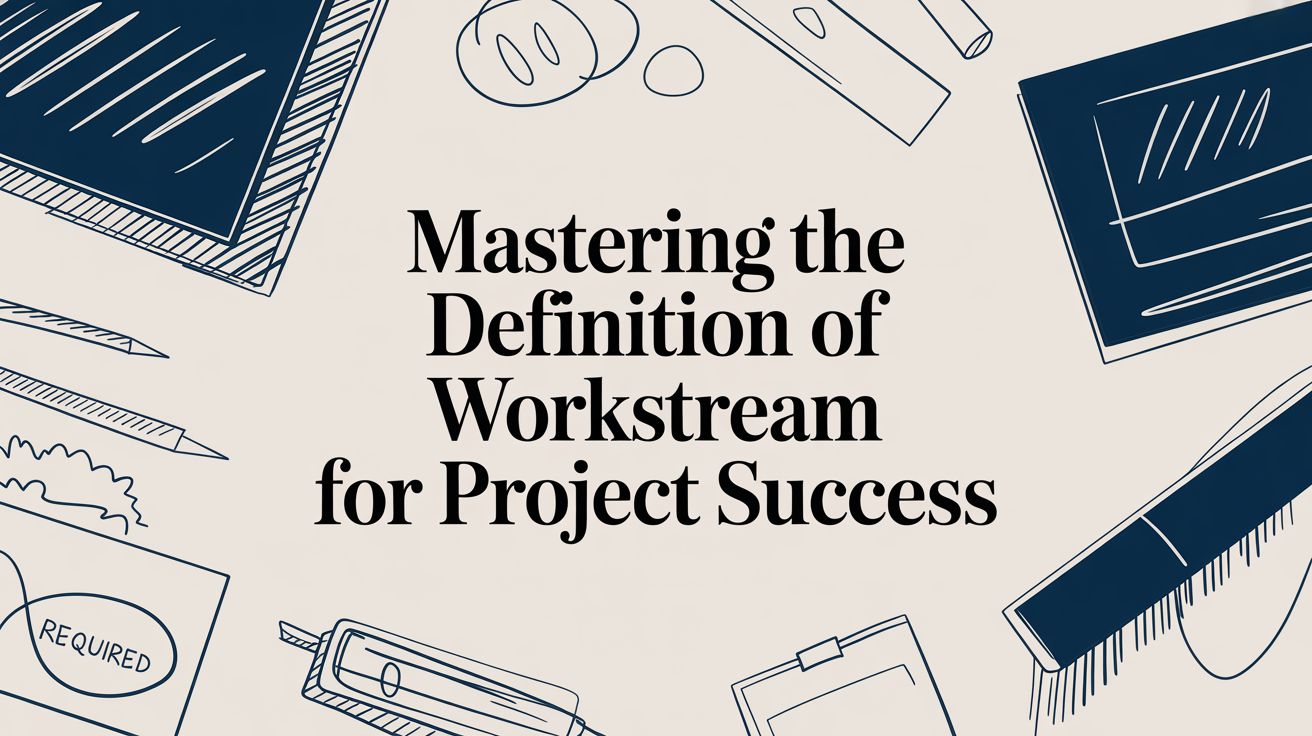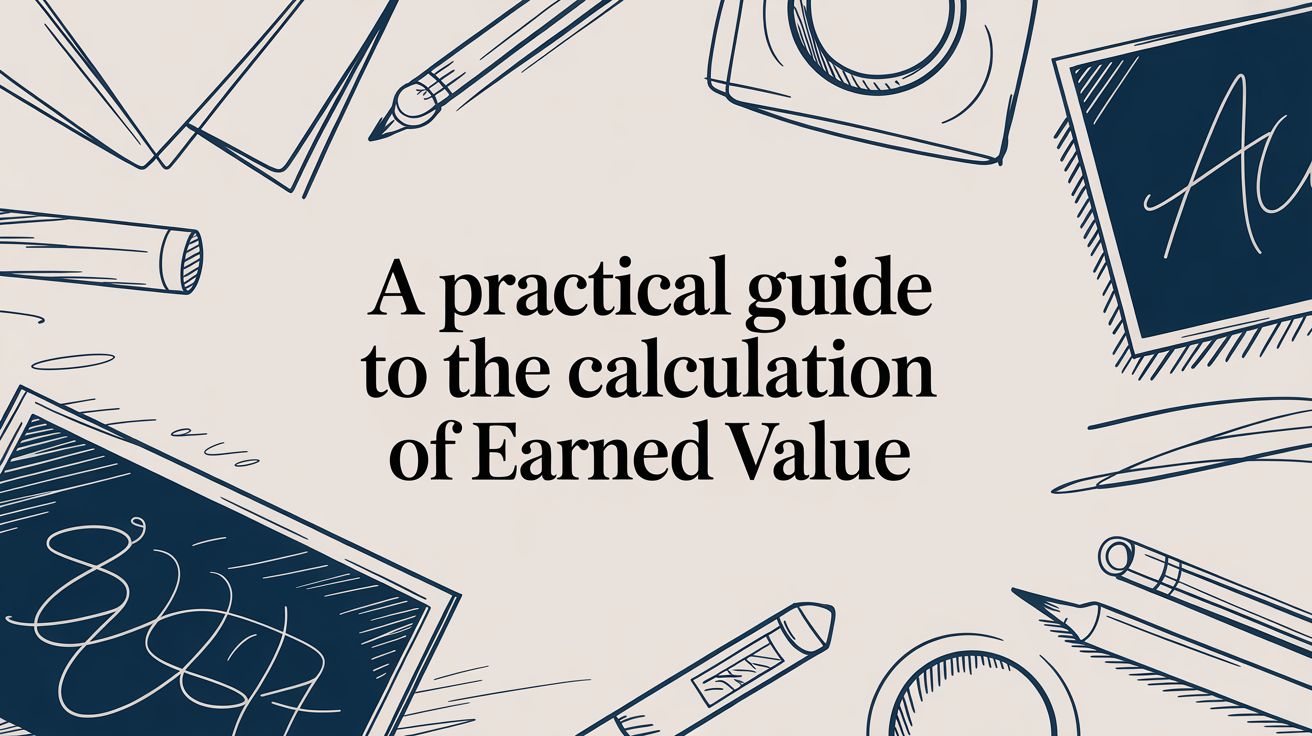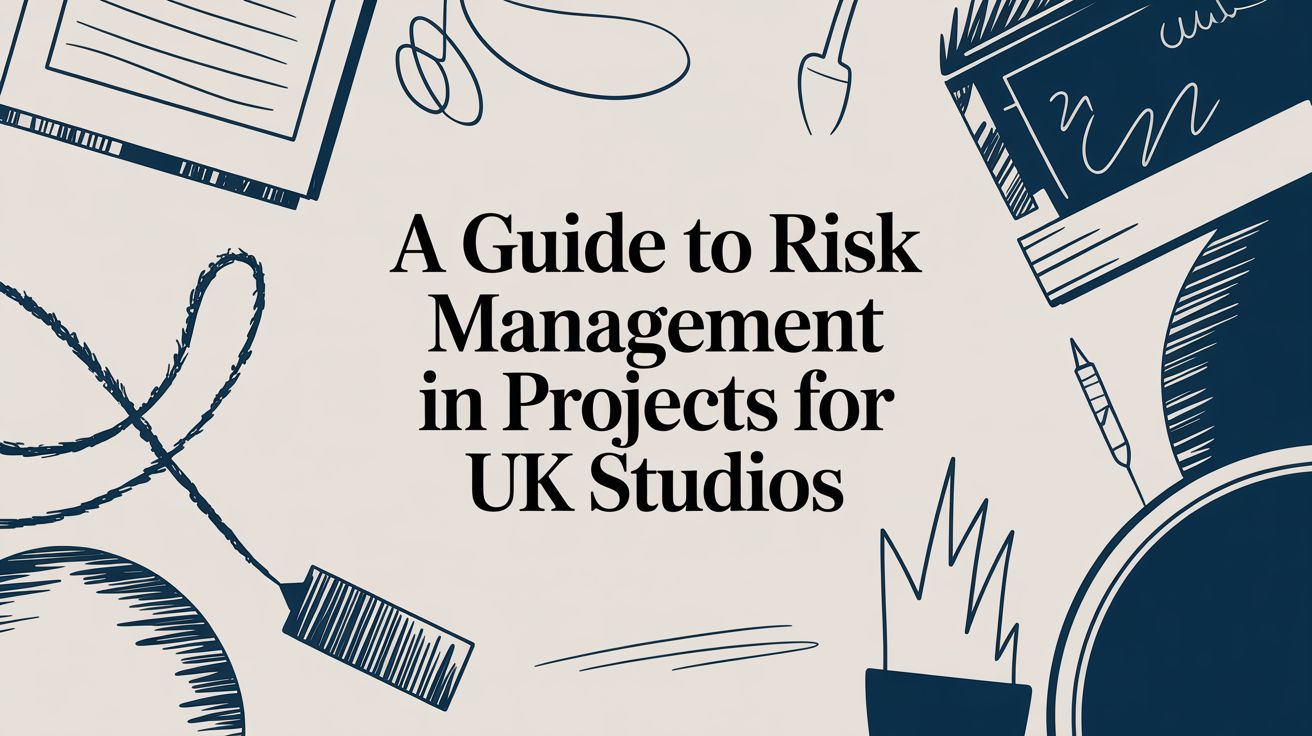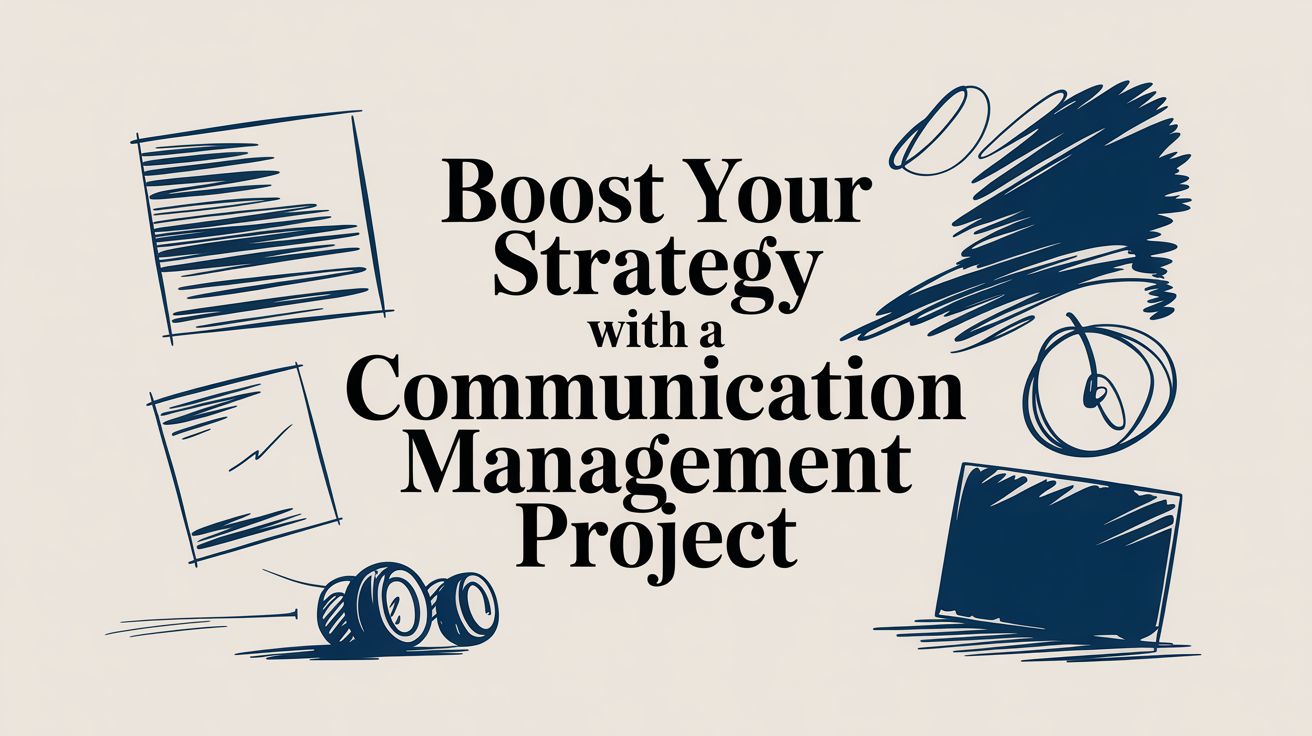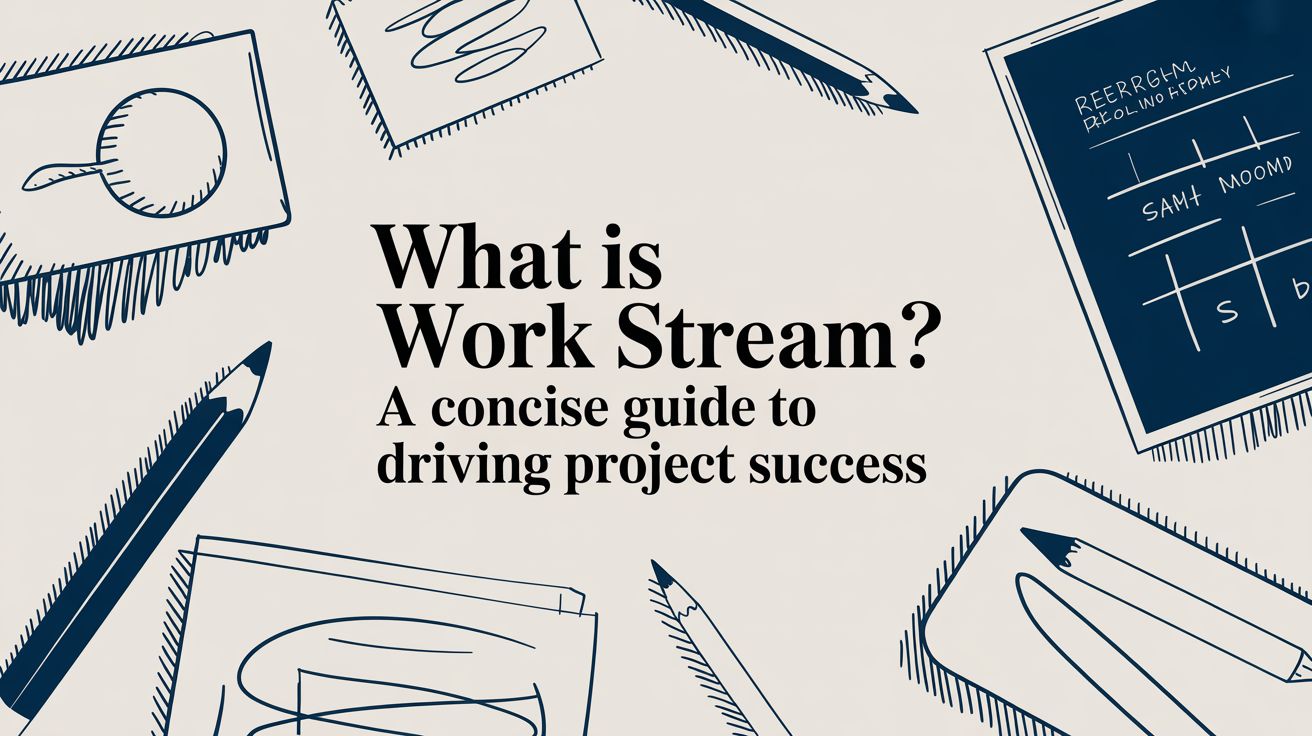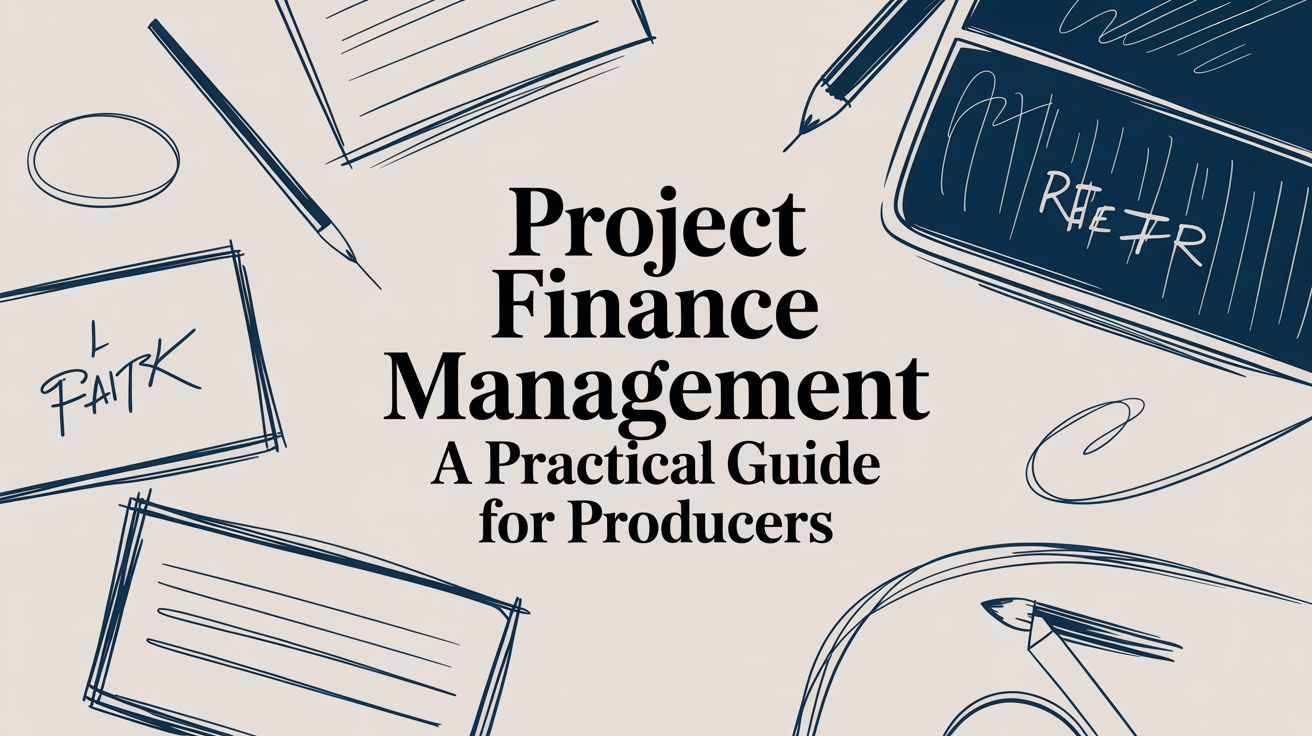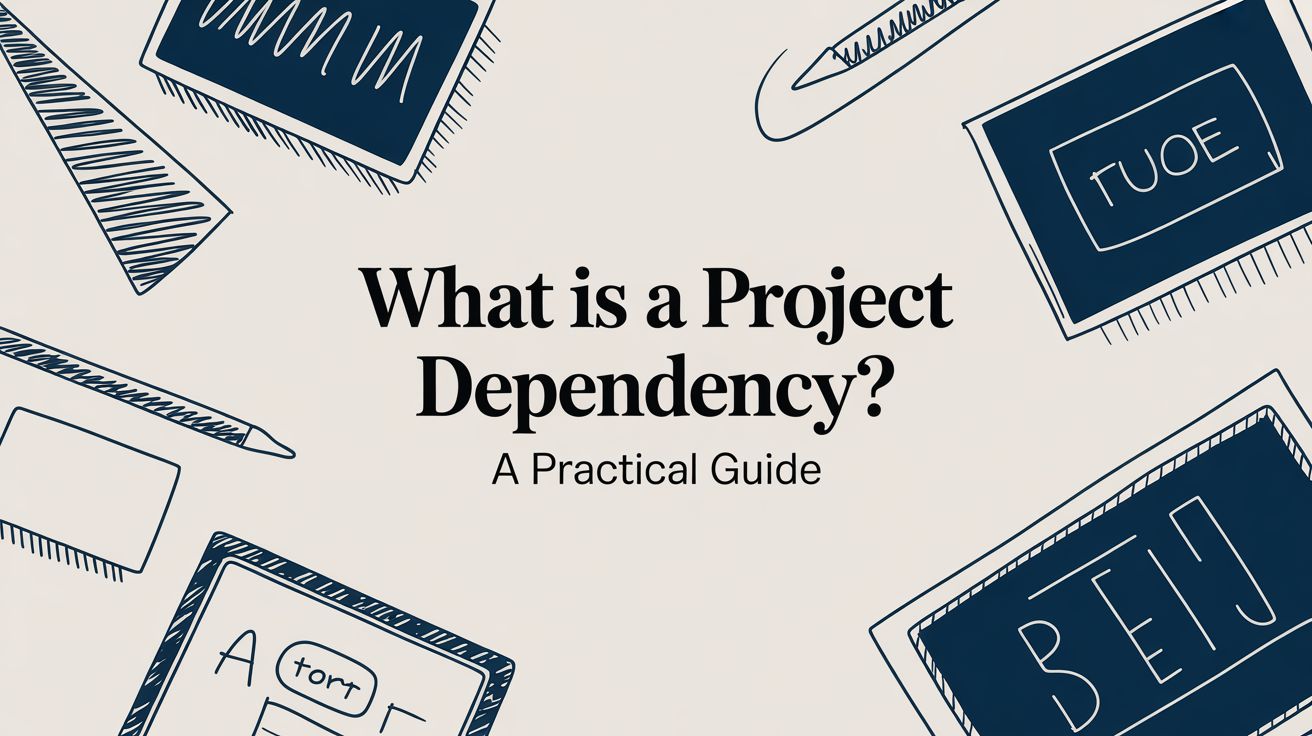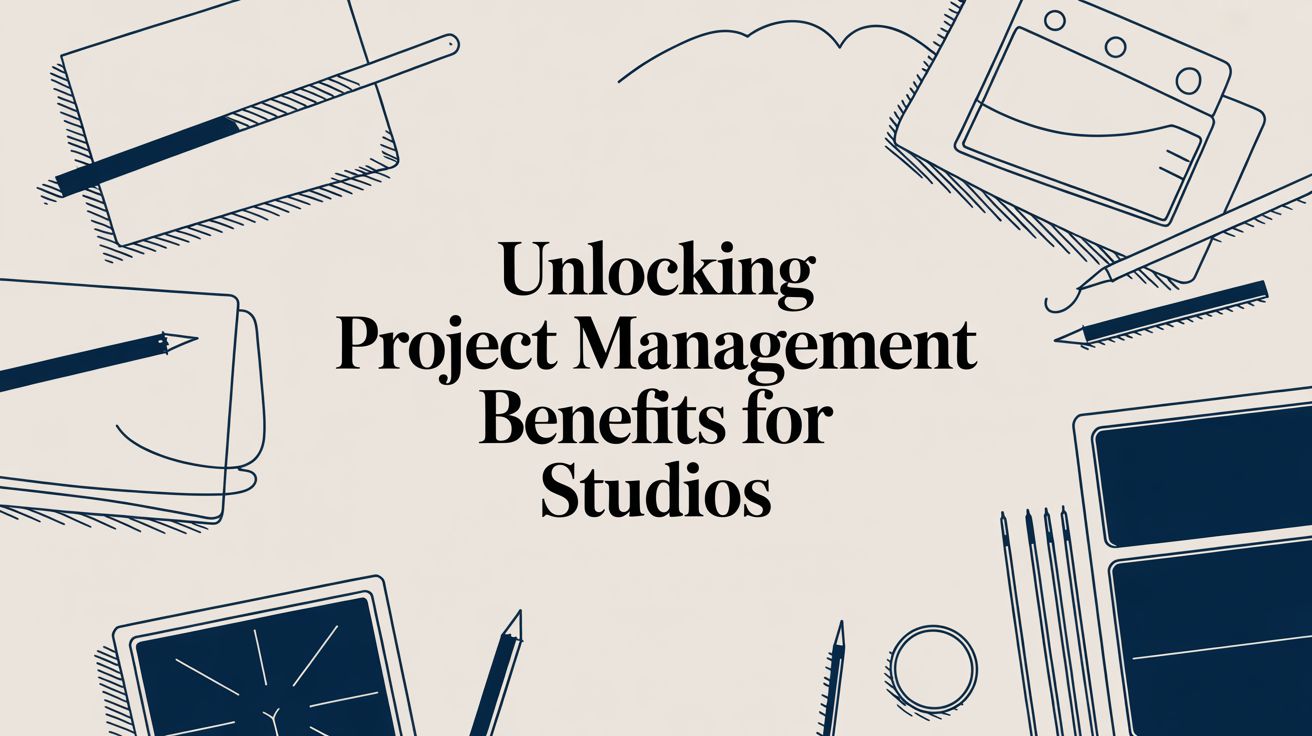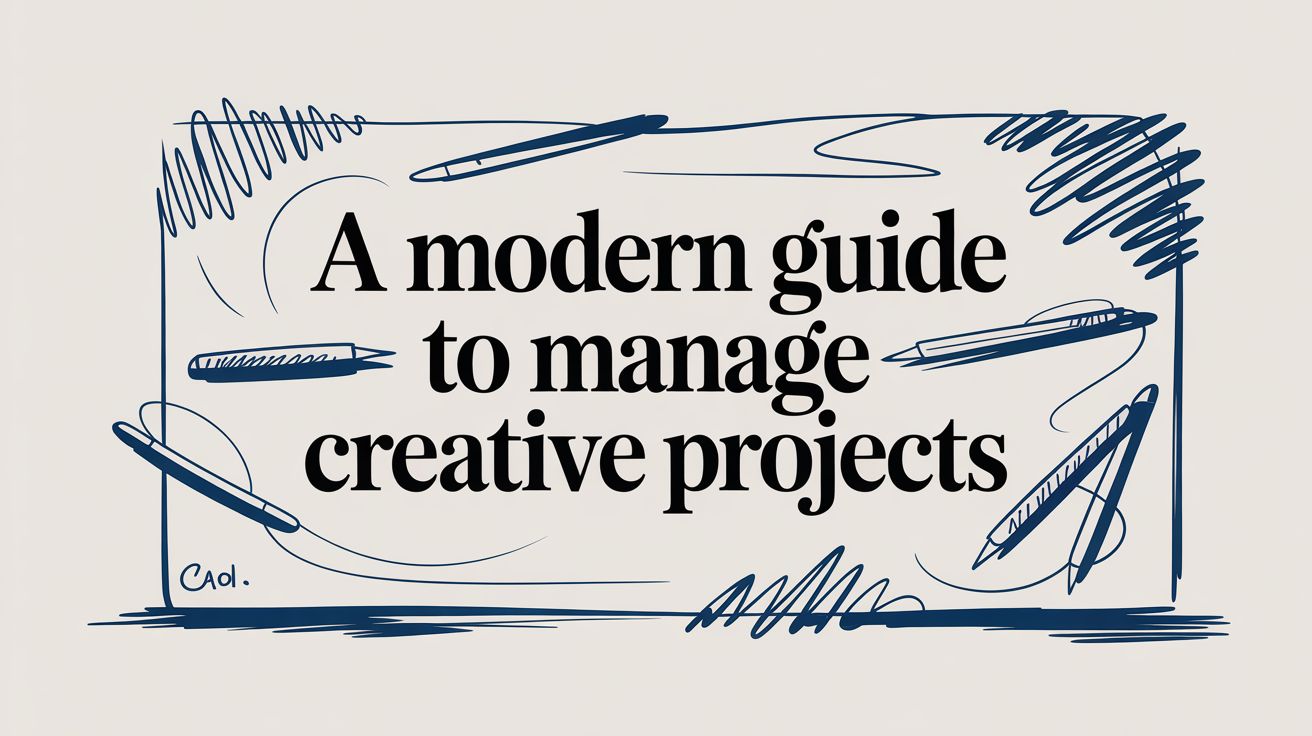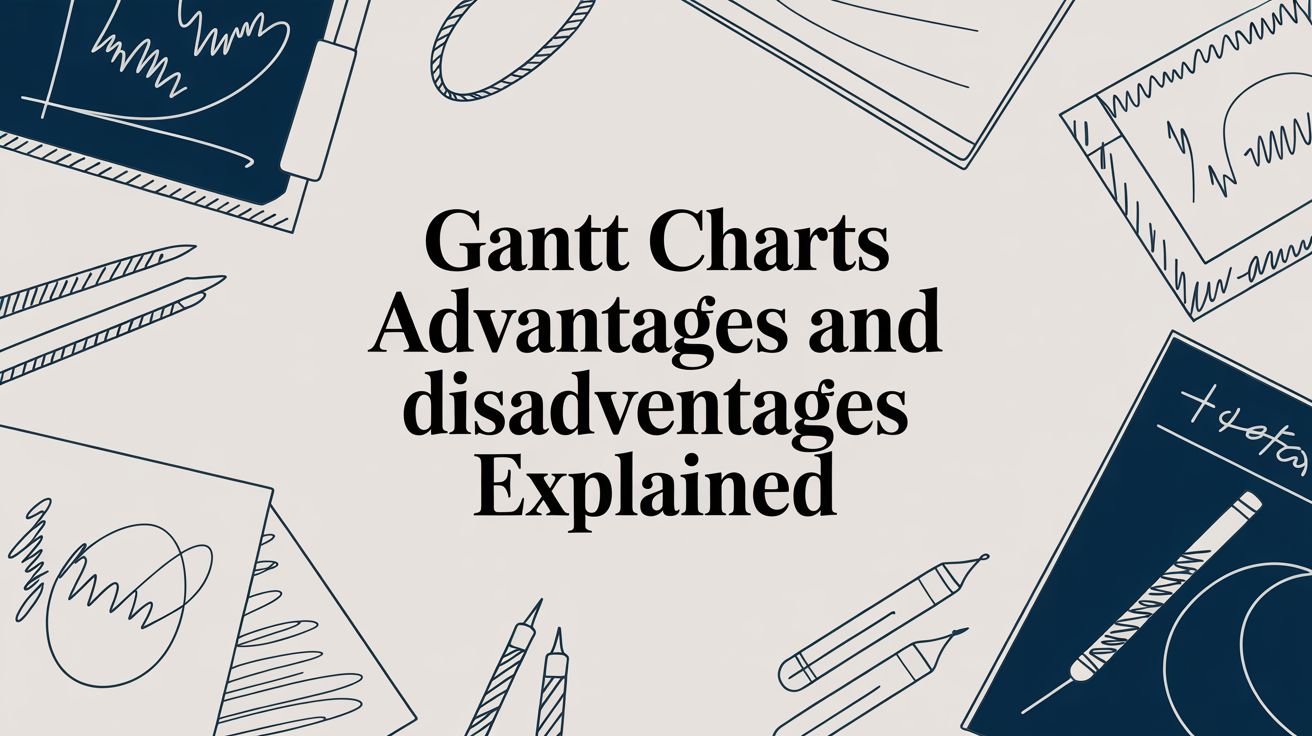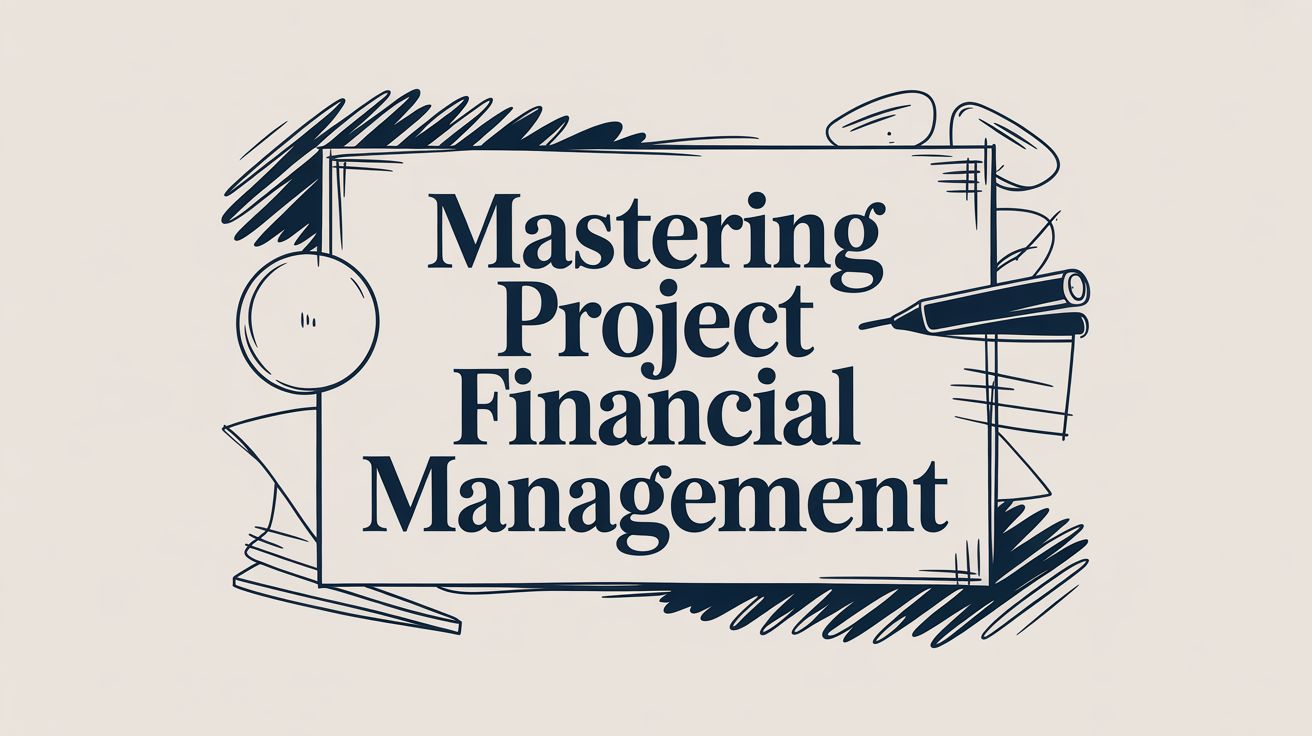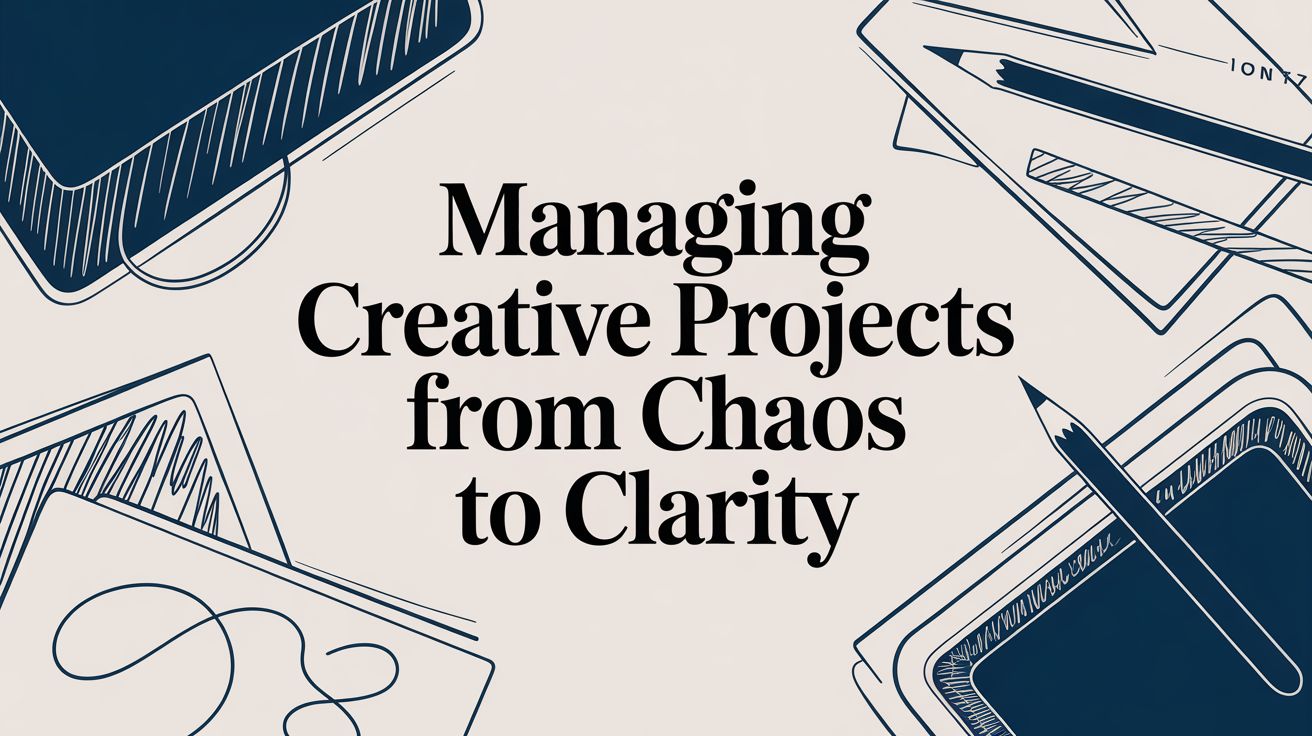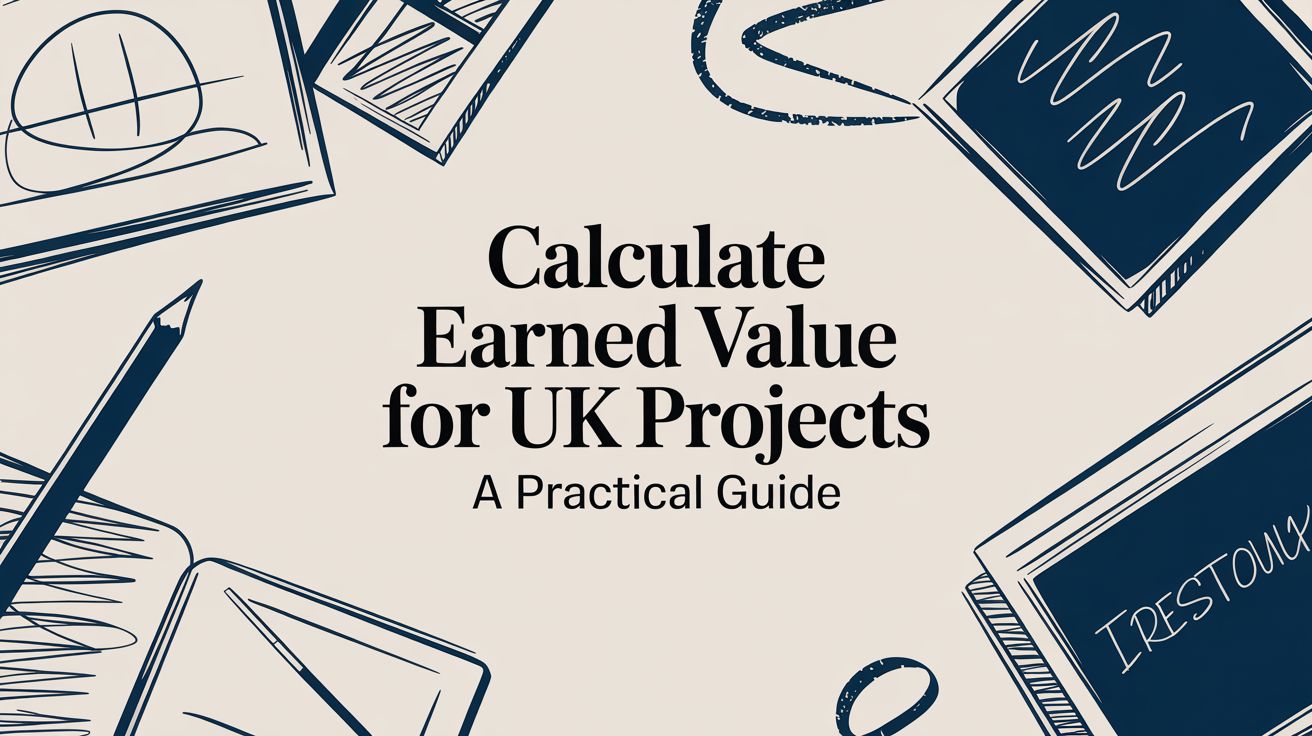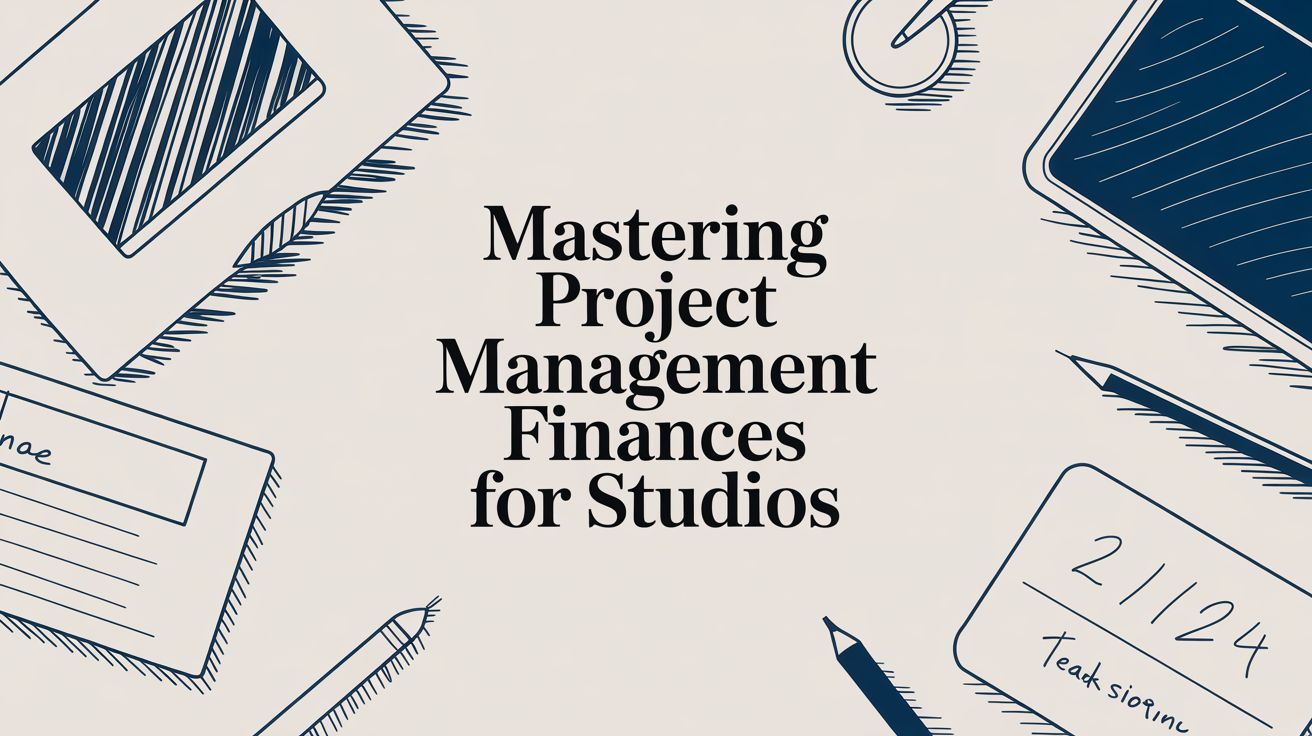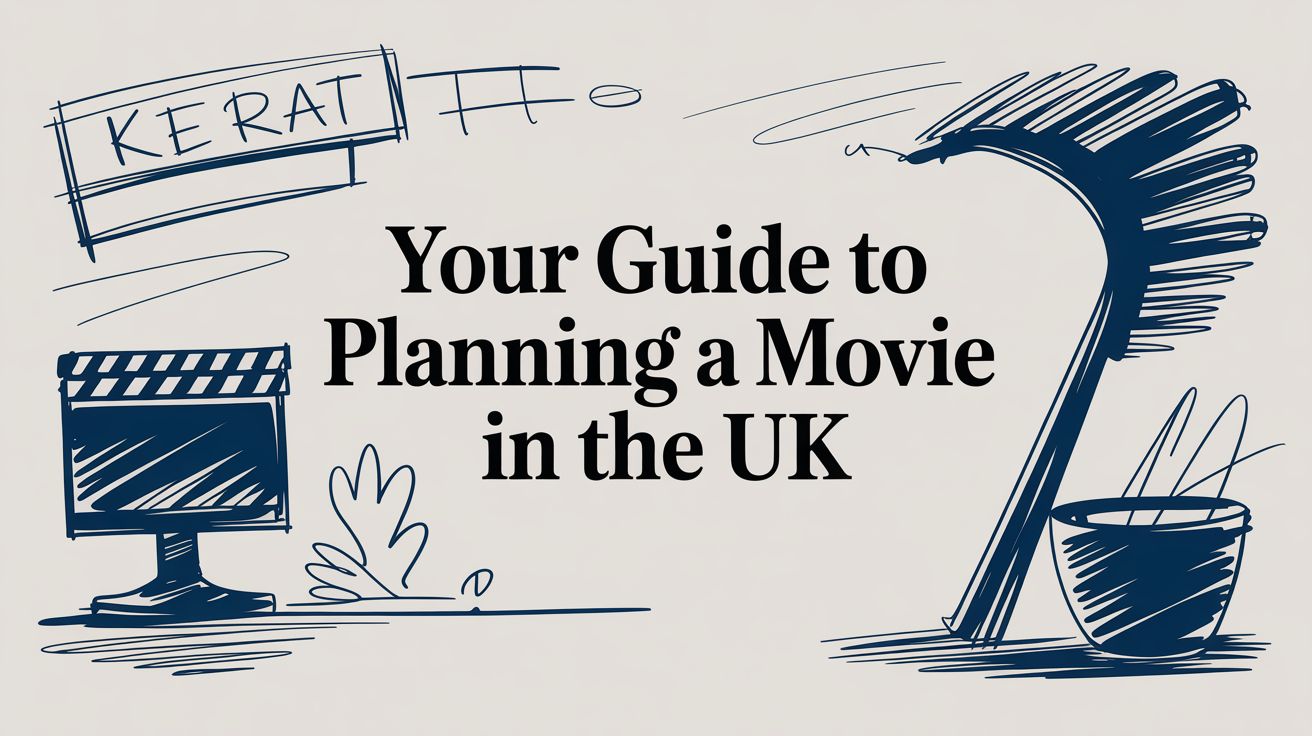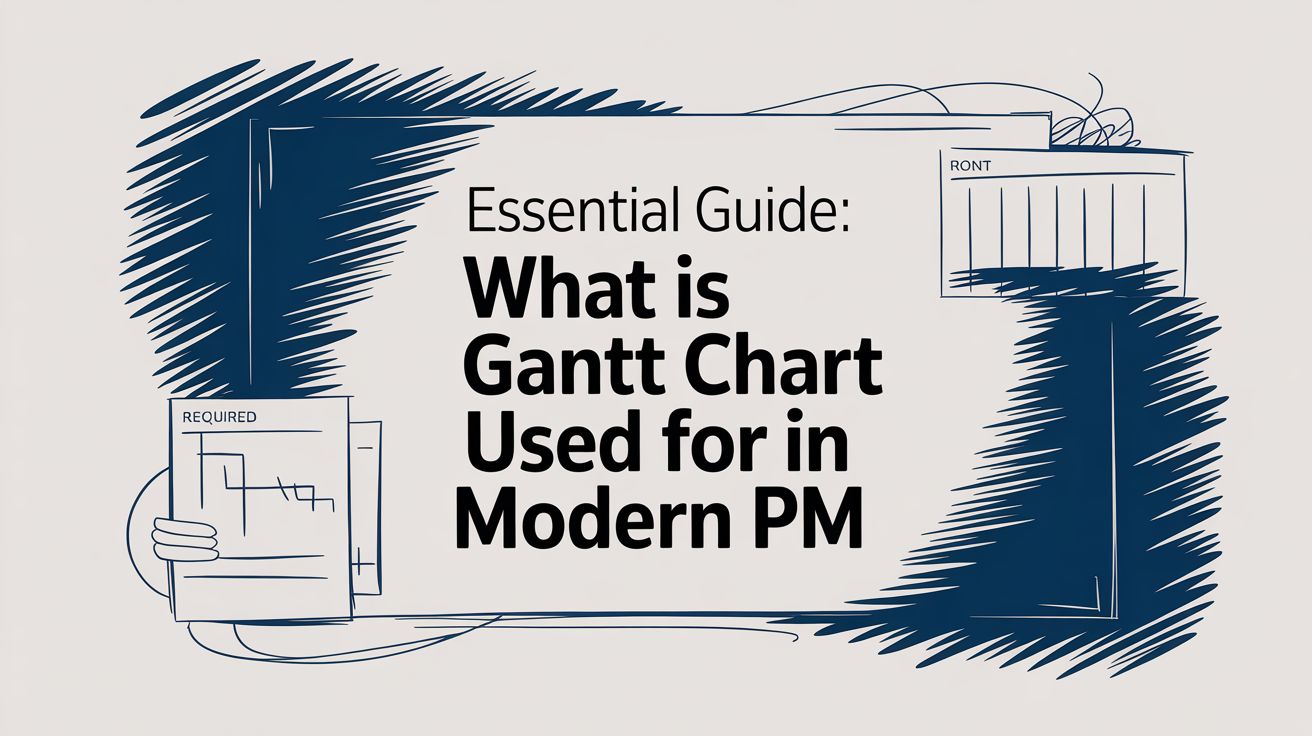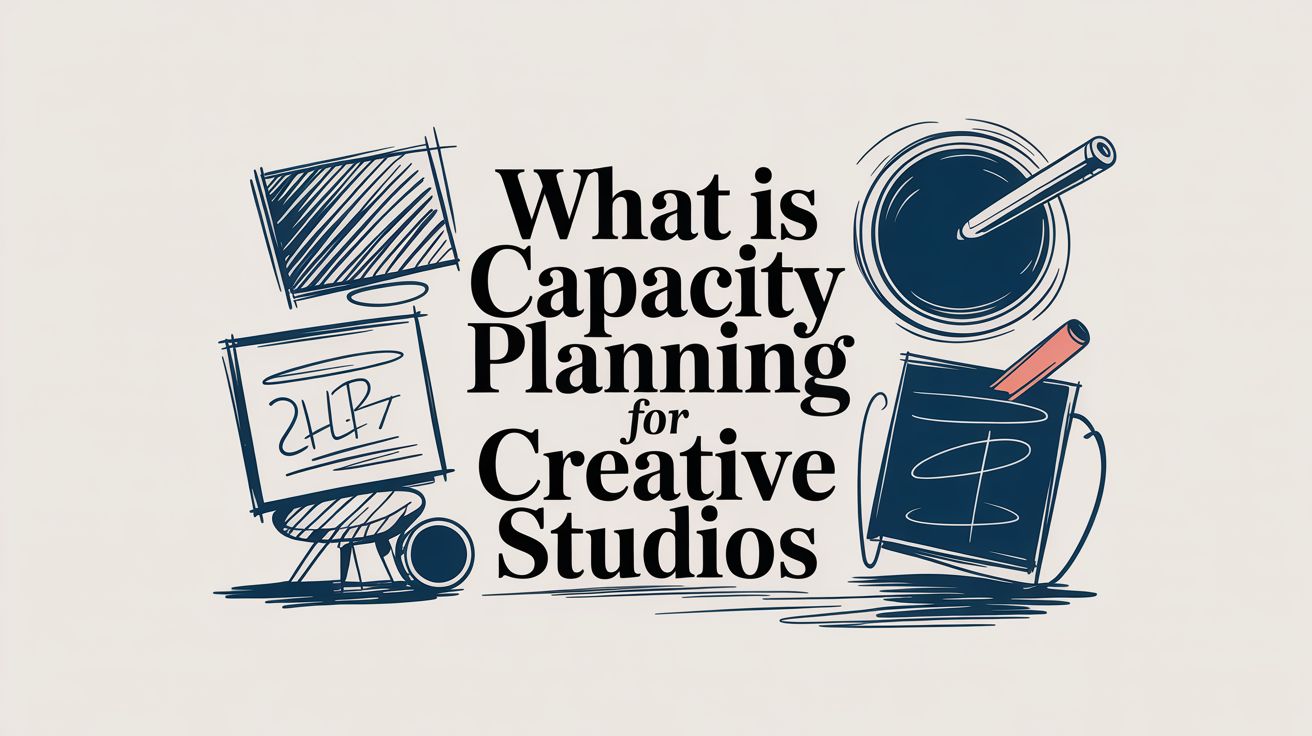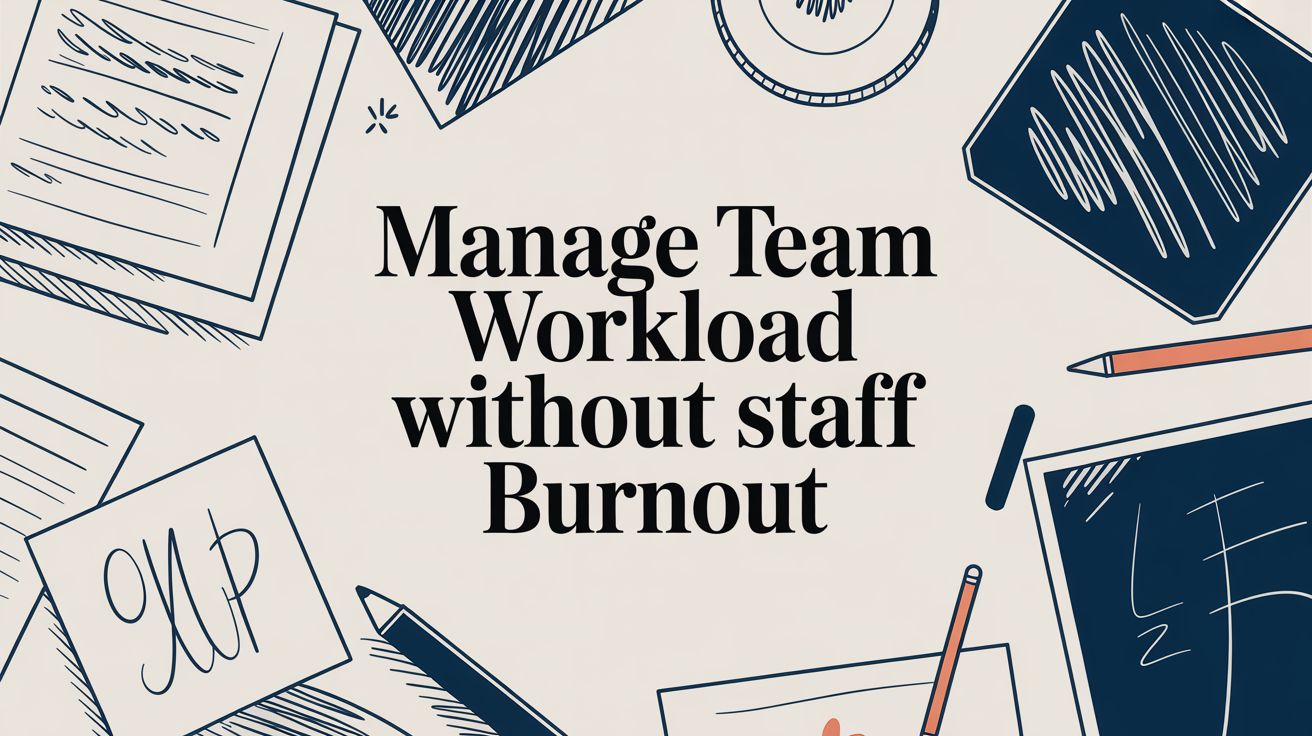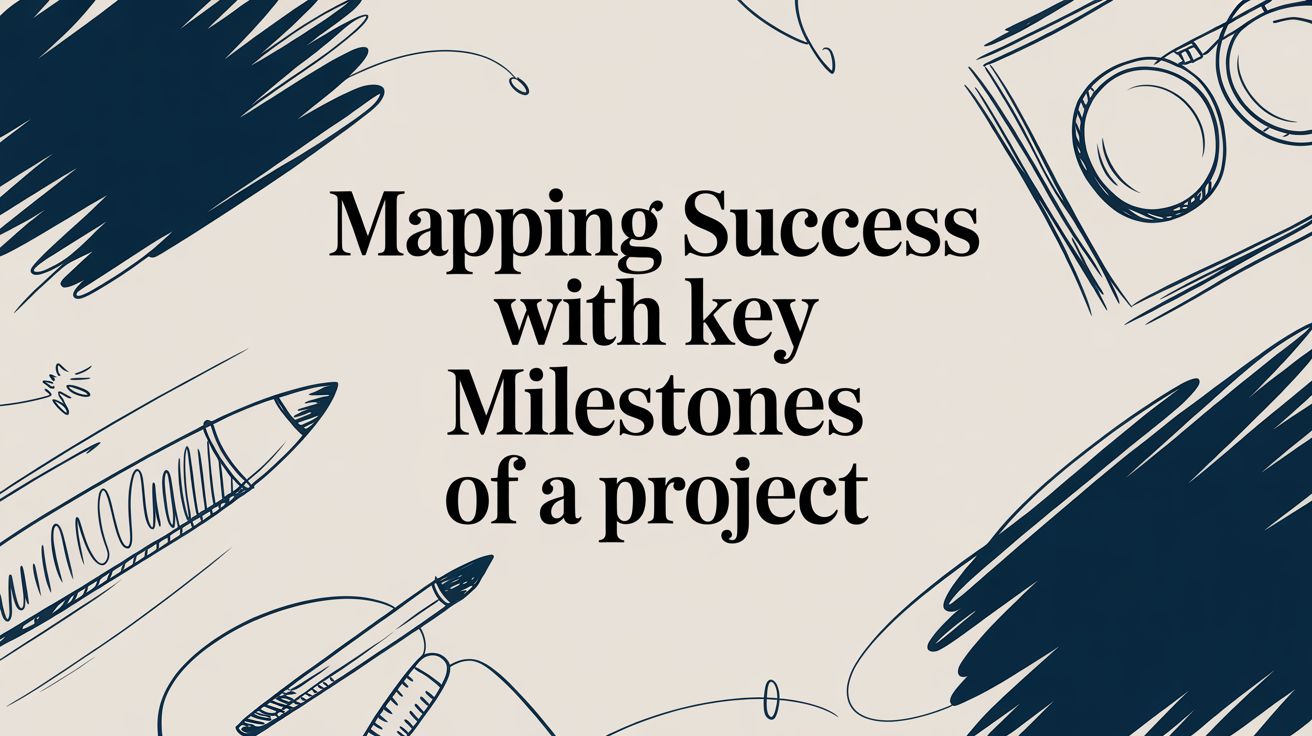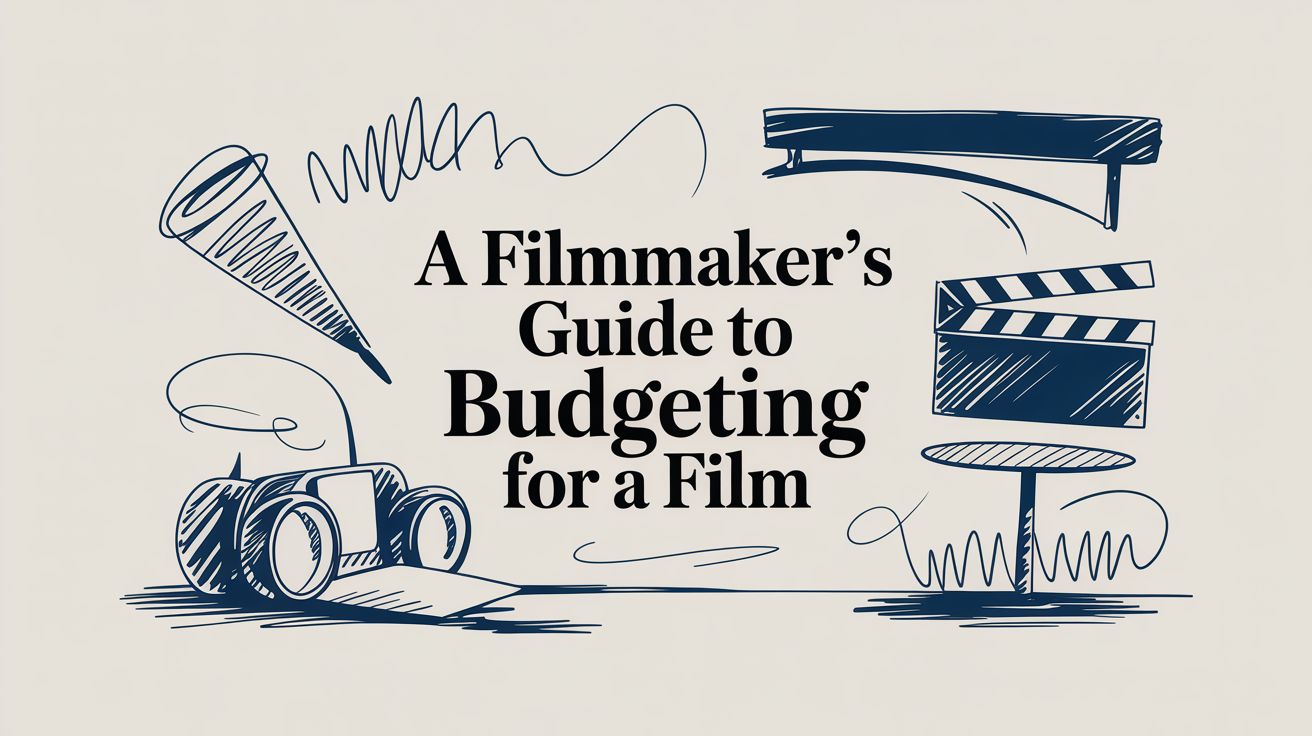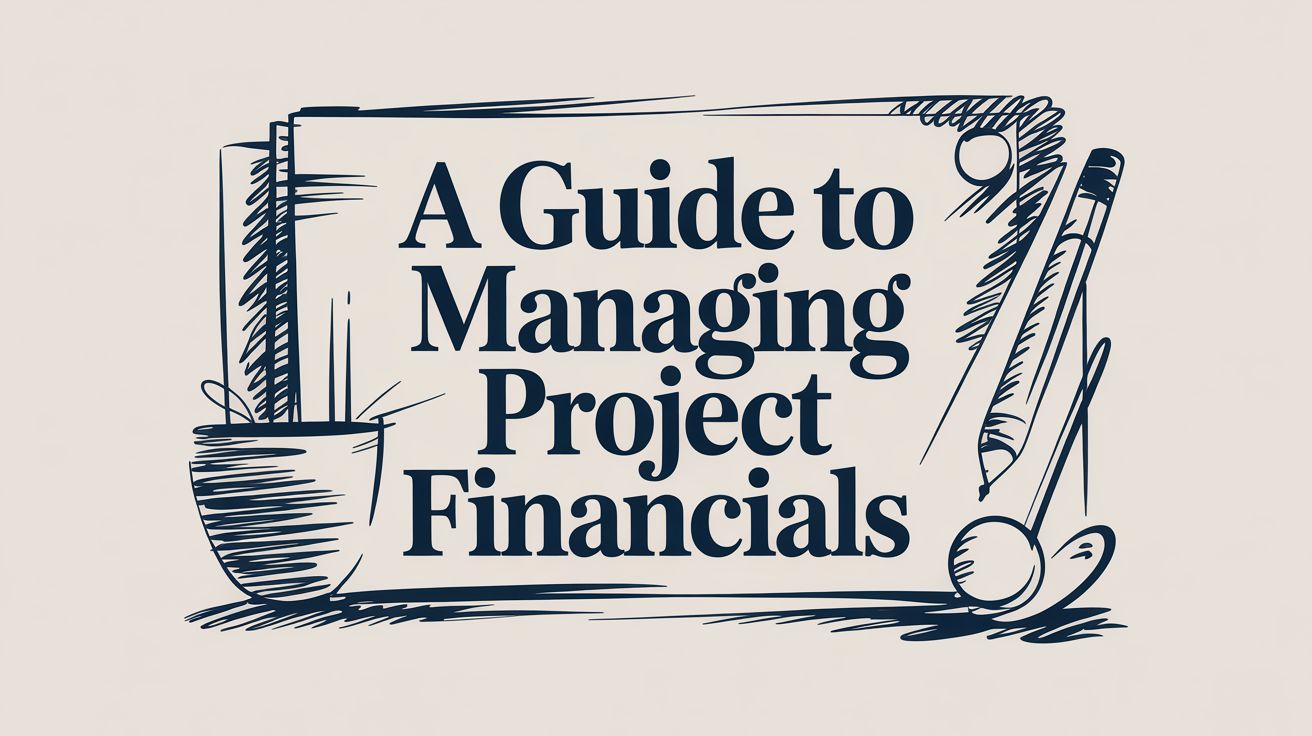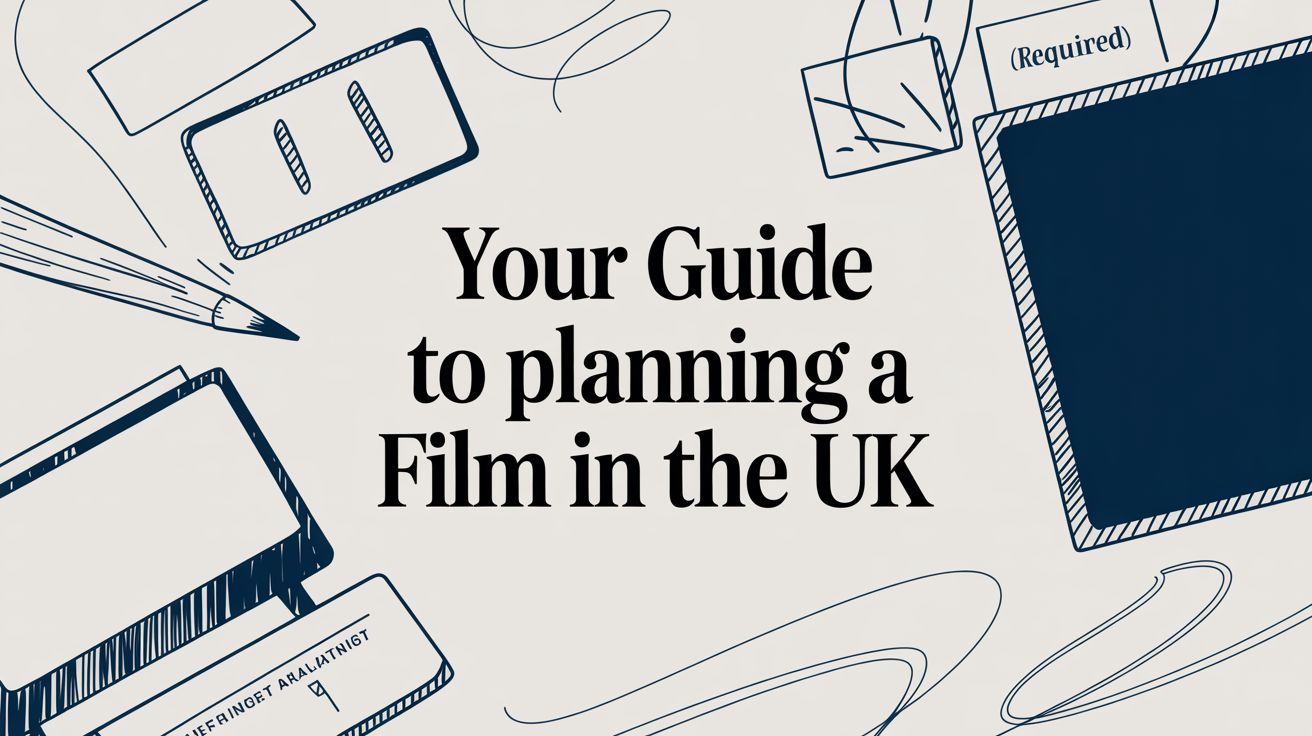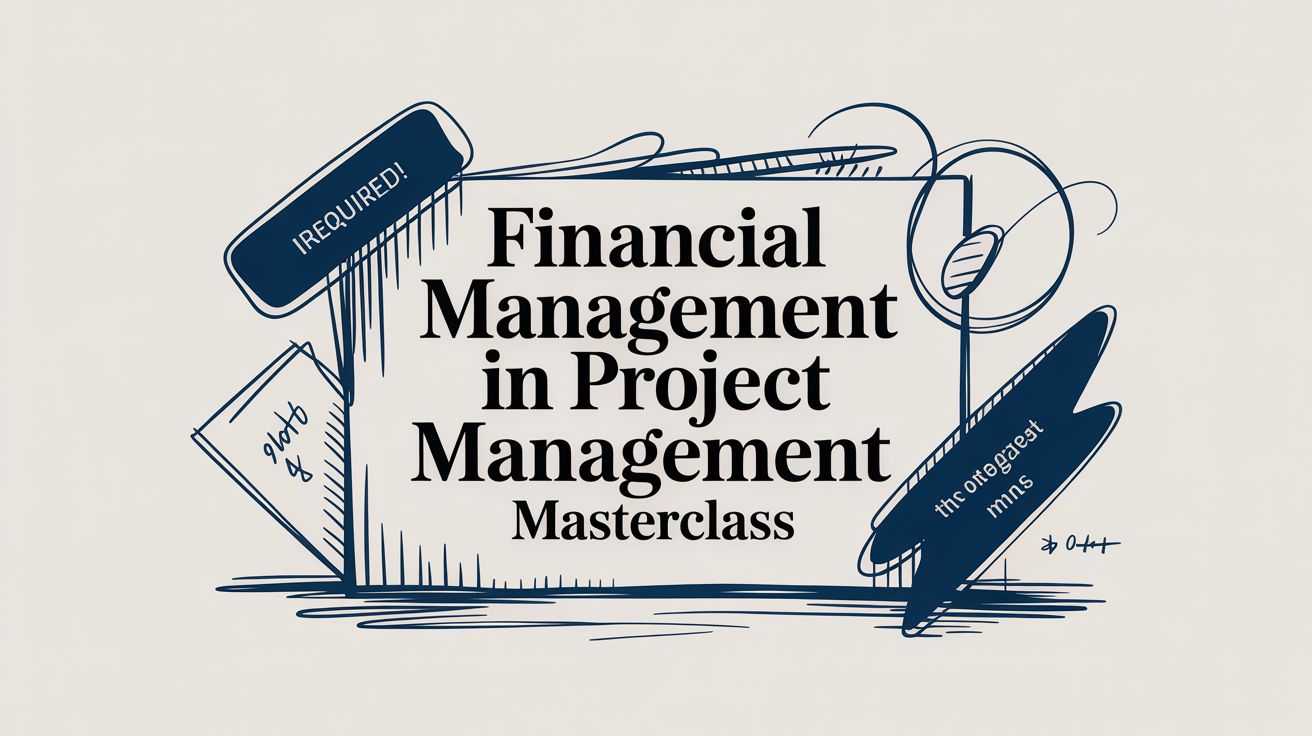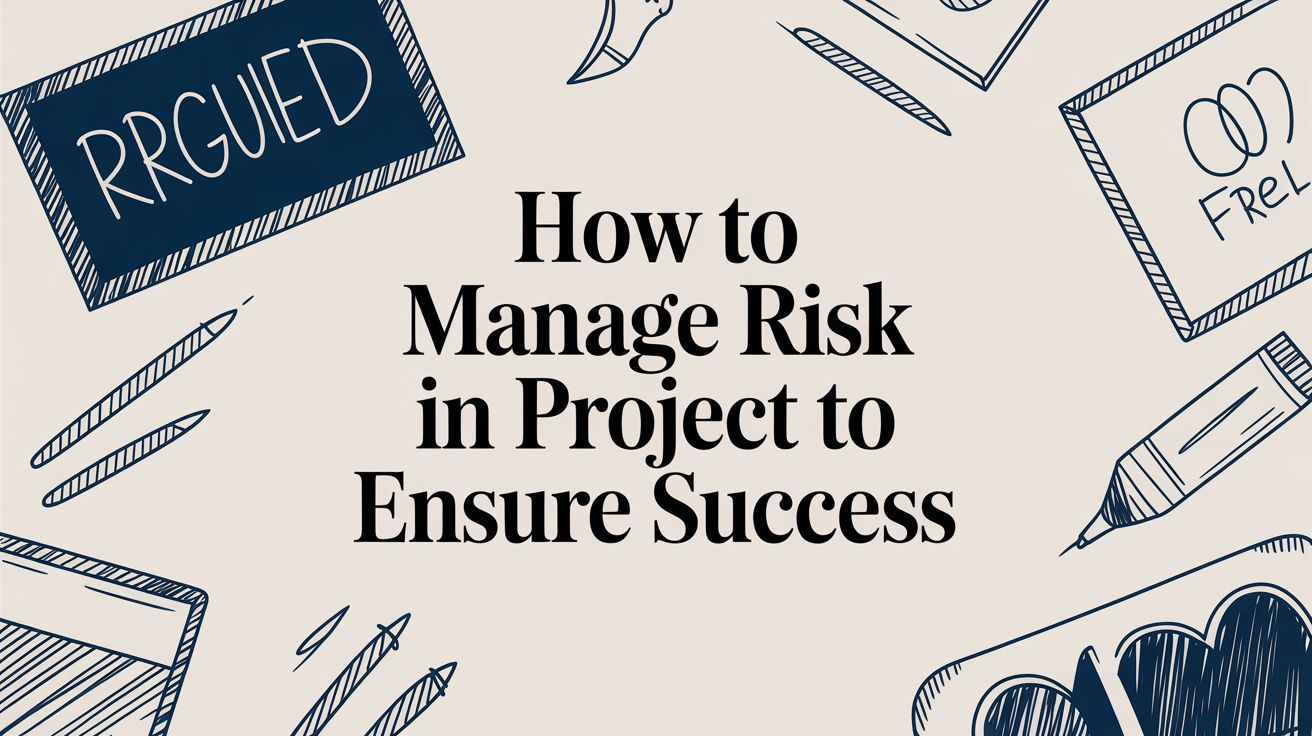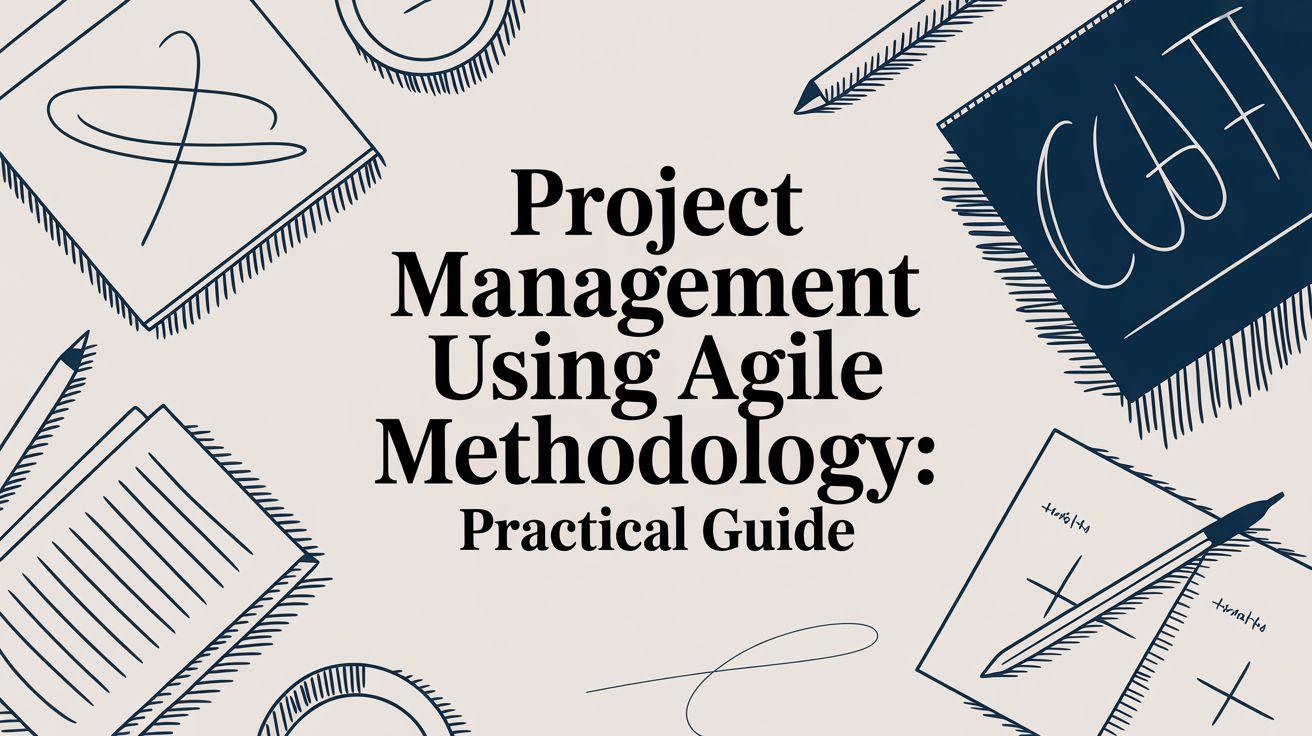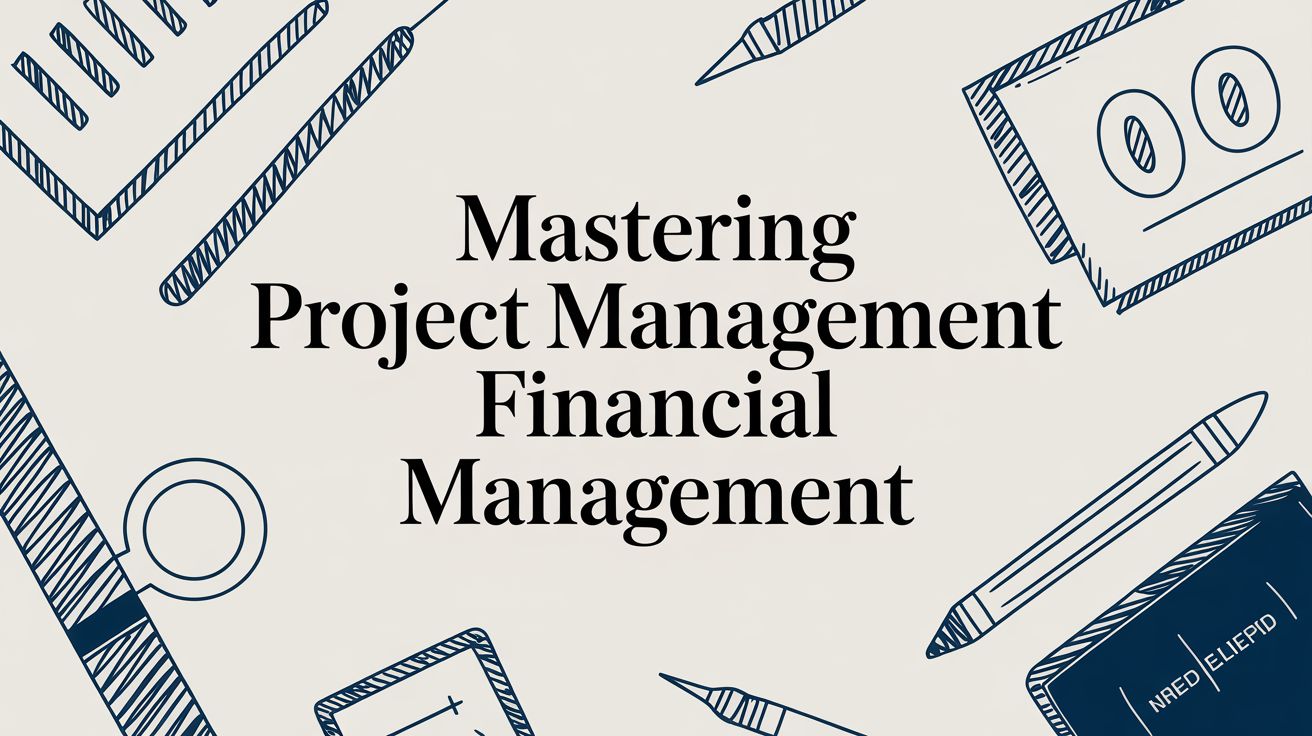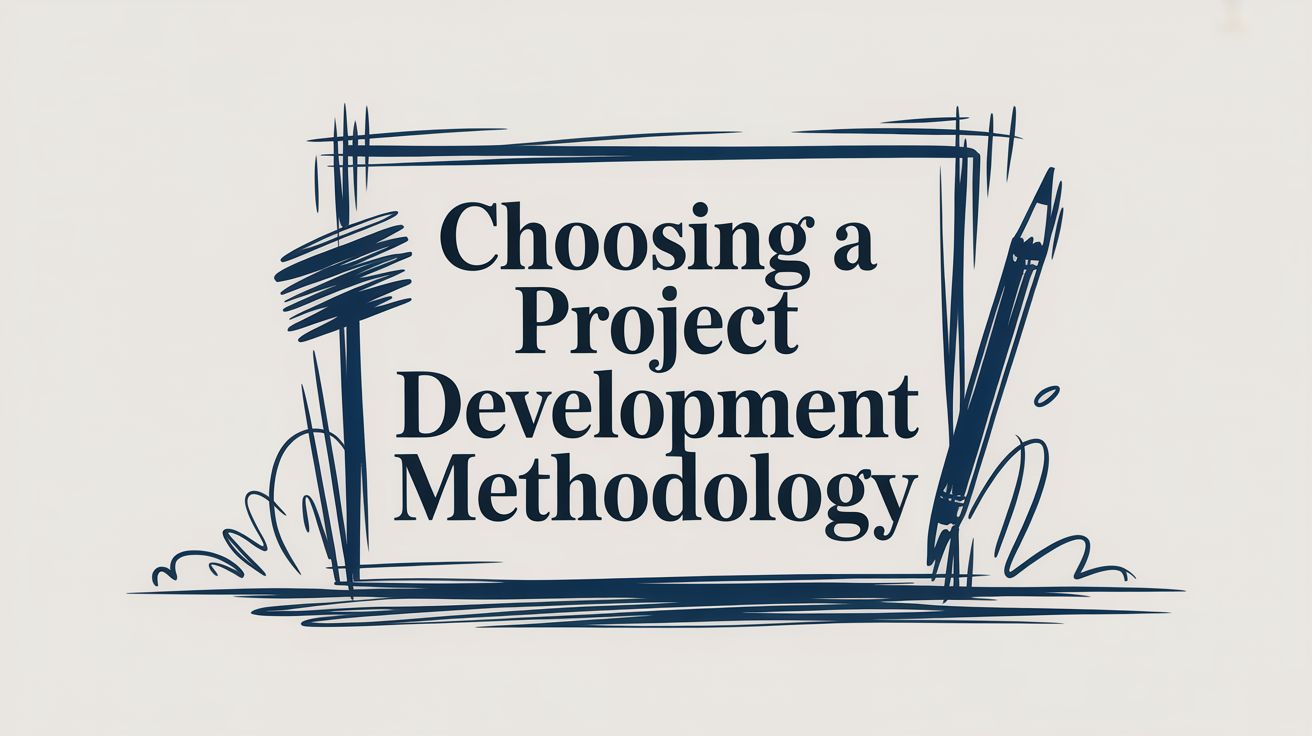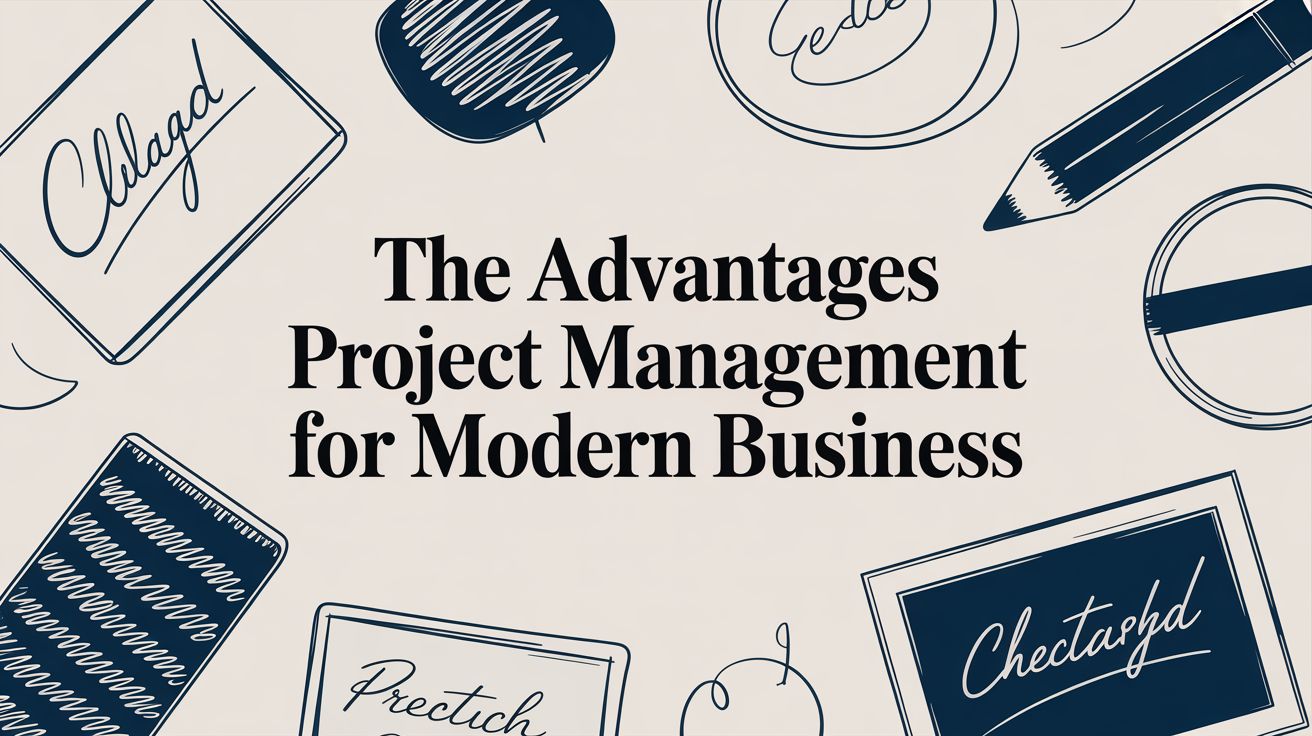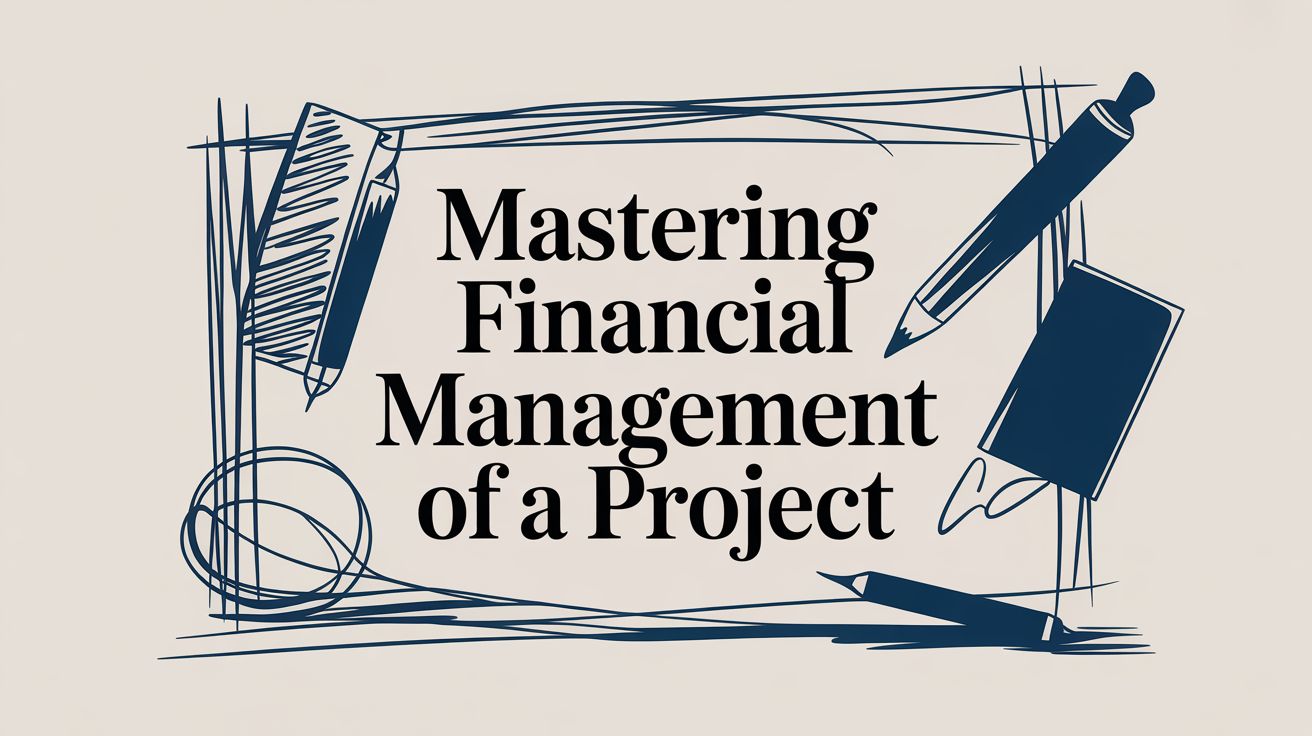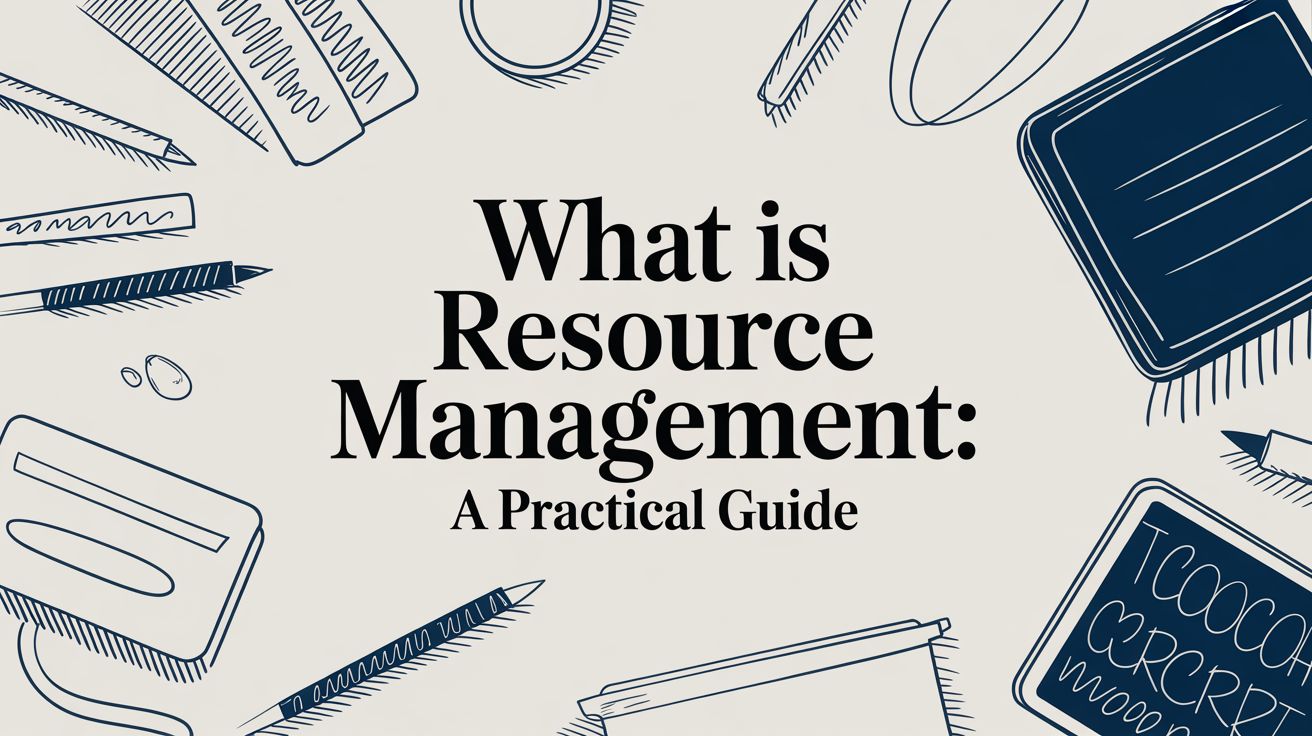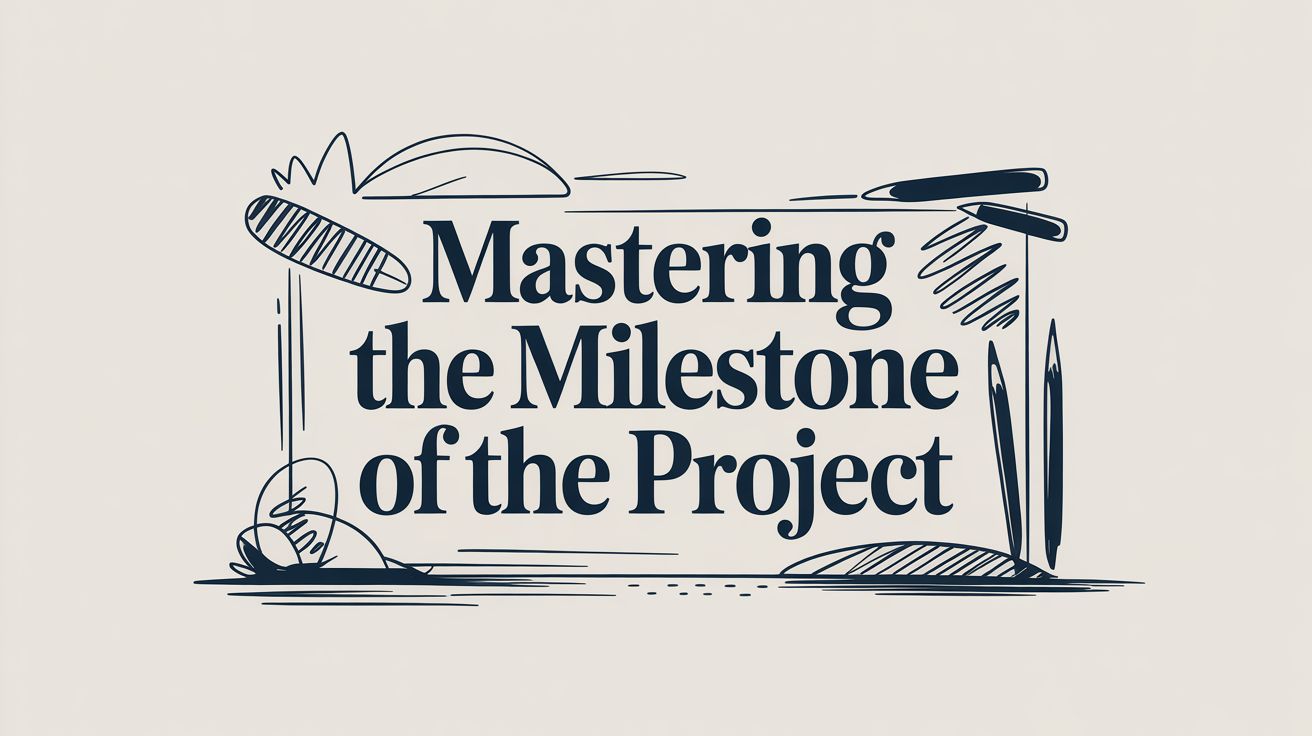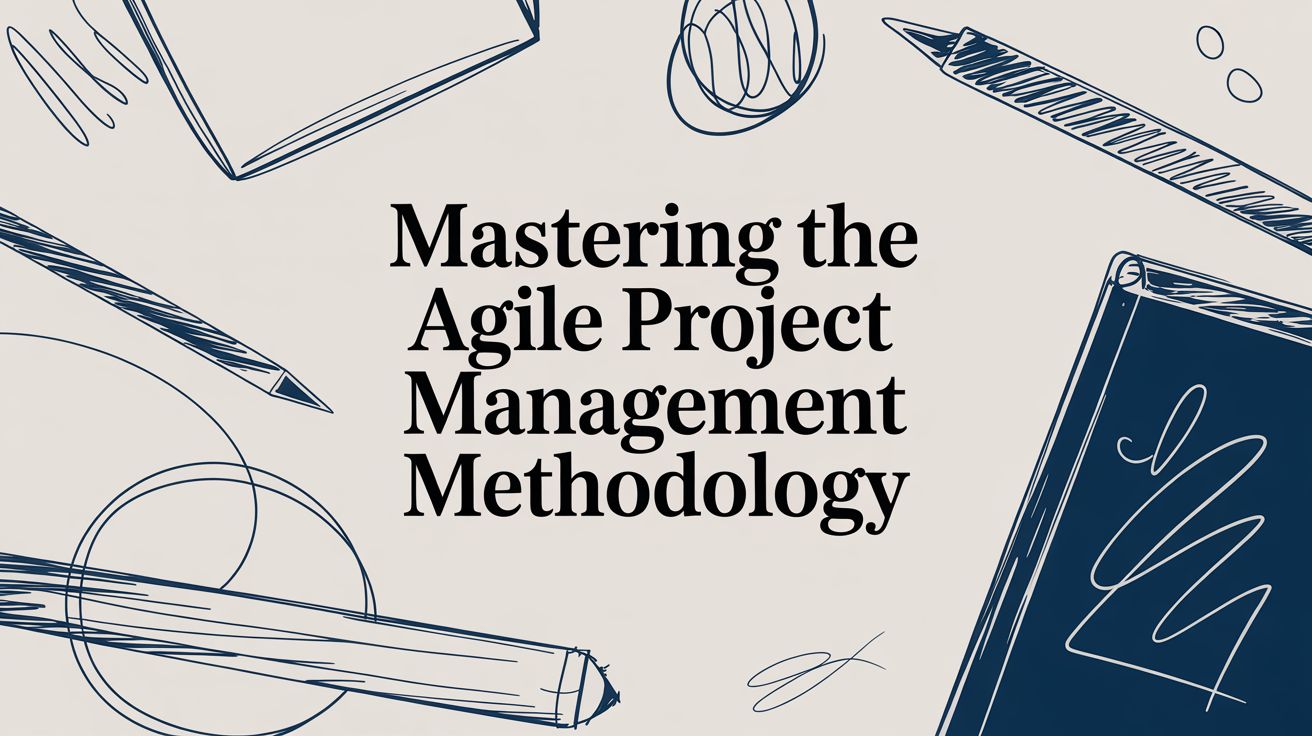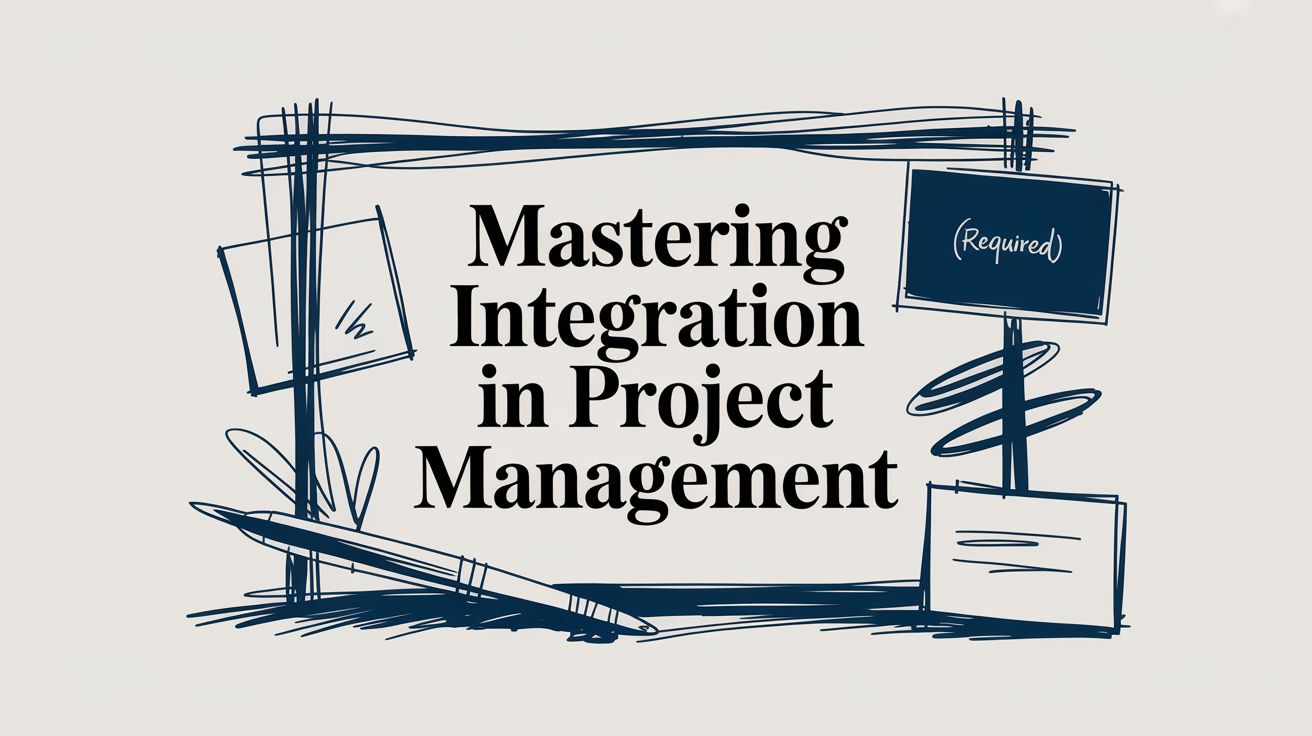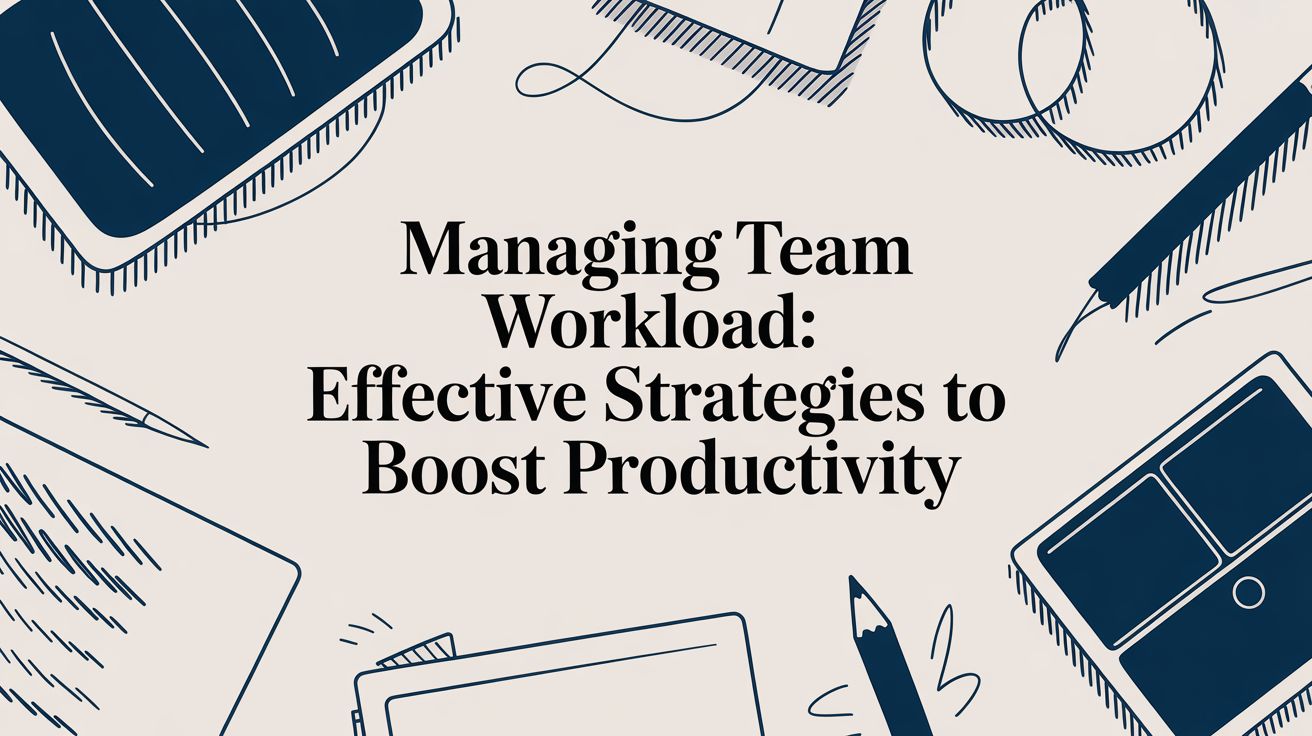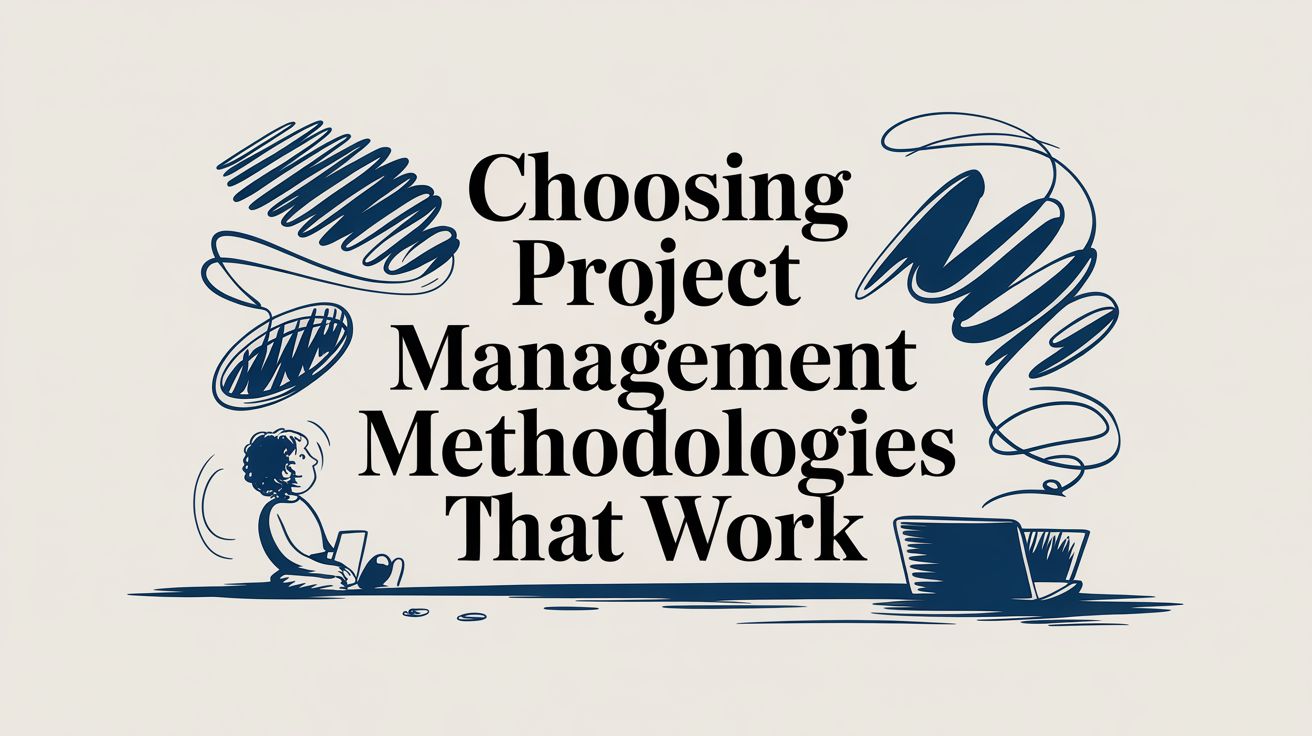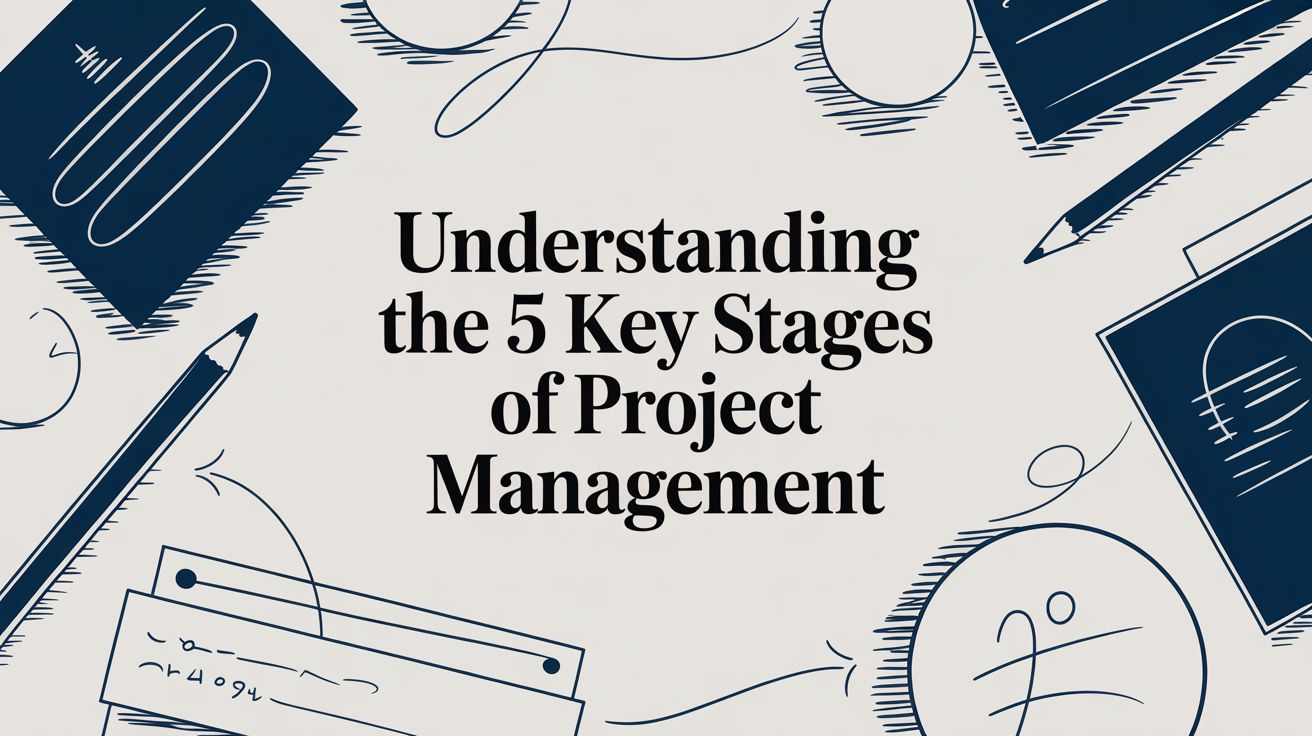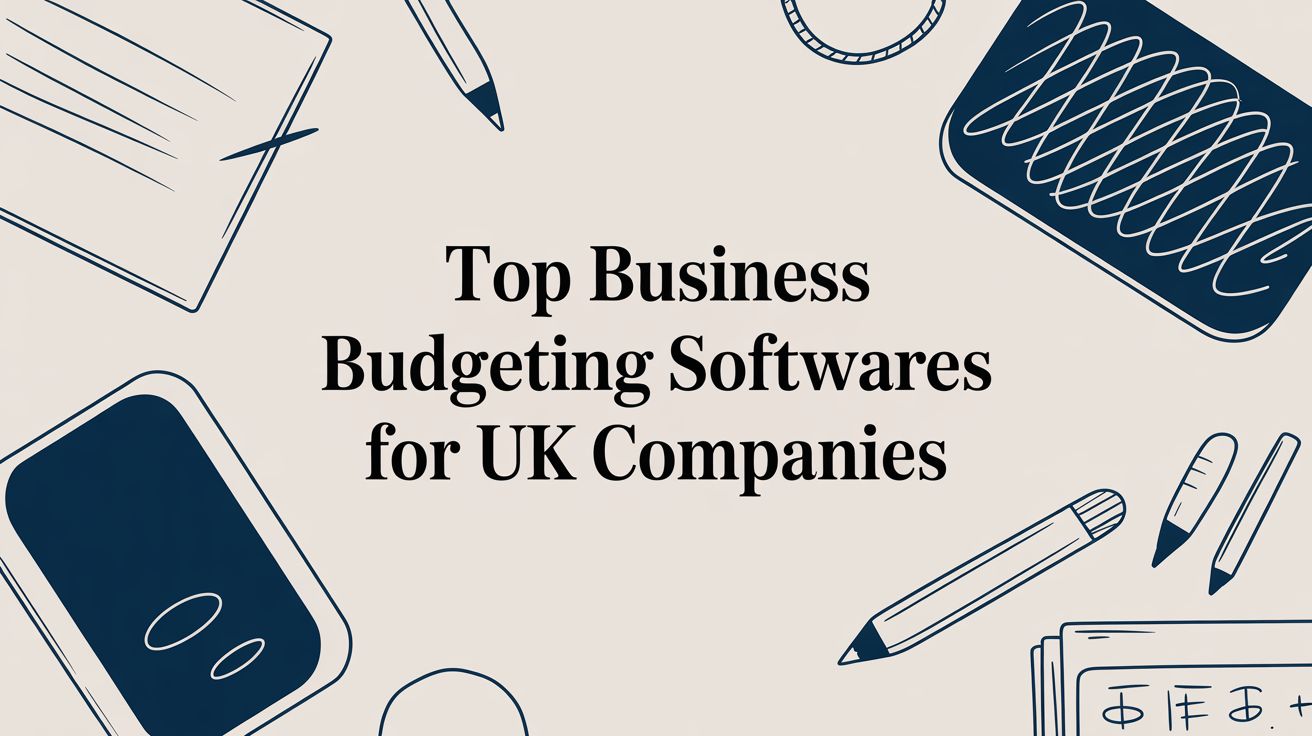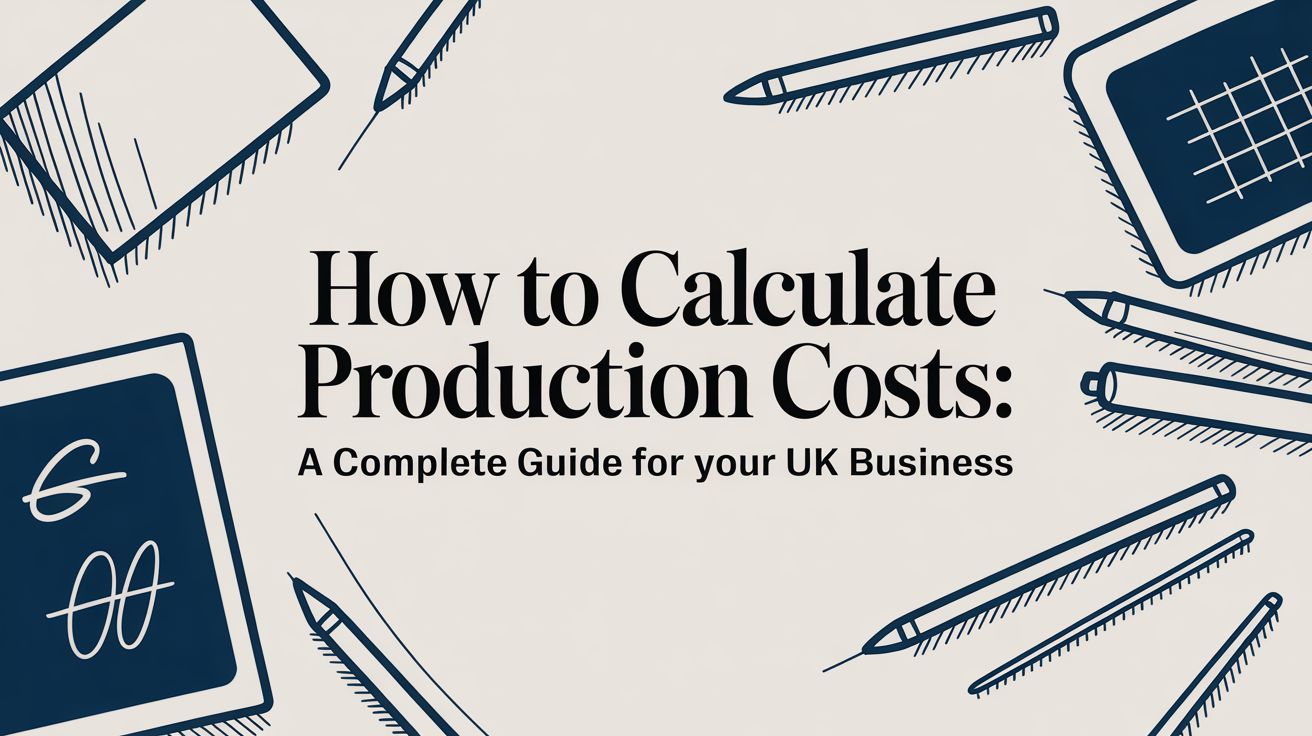Let's be honest, project management for creative teams is a different beast altogether. It's the specialised craft of planning, executing, and delivering projects where creativity is the main ingredient. This isn't about rigid spreadsheets or predictable Gantt charts; it's about building a flexible framework that can handle the beautifully messy and unpredictable nature of creative work.
The goal is simple: provide just enough structure to get those brilliant ideas over the finish line without crushing the spark that makes them special in the first place.
Why Managing Creatives Is a Unique Challenge
Overseeing a creative project isn't like managing a construction site. It's far more like conducting an orchestra. Each person is a master of their instrument, but you need someone to bring all that individual talent together into one, powerful performance. That's the real heart of project management for creative teams.

This is precisely where standard, by-the-book project management tends to fall flat. It's built for linear, predictable tasks. But creative work? It thrives on exploration, constant iteration, and those occasional bursts of chaotic genius. Try to force a rigid, step-by-step process onto that, and you'll just end up with frustrated teams and mediocre results.
The Balancing Act of Freedom and Deadlines
The biggest challenge is walking the tightrope between artistic freedom and the cold, hard reality of client deadlines and budgets. Creatives need room to breathe, to experiment, to innovate. But at the end of the day, the project has to be delivered on time and on budget.
A great creative project manager acts as a buffer. They shield the team from the chaos of endless client revisions while making sure the project’s commercial goals are always in sight.
This delicate balance is absolutely crucial, especially for agencies where keeping clients happy is everything. If you're keen to dive deeper into these unique agency-specific hurdles, this ultimate guide to project management for agencies is a fantastic read.
Here’s where creative project management really parts ways with the traditional playbook:
- Subjective Success Metrics: How do you put a number on "make it pop"? Success is often about emotional impact and aesthetic quality, things you can't just check off a list.
- Non-Linear Workflows: Ideas evolve. A designer might get feedback on a prototype and realise they need to jump back to the initial concept phase. This kind of loop breaks a traditional, sequential plan.
- Valuing the Process: The journey itself—the discovery, the detours, the happy accidents—is just as important as the final file. The most groundbreaking work often comes from a process that leaves room for the unexpected.
The real aim of project management for creative teams isn't about control; it's about creating a supportive framework. It's a system designed to protect and channel creative energy, ensuring that brilliant ideas don't just stay ideas.
The Economic Importance of Creative Management
Getting this right isn't just about smoother internal workflows; it's a massive deal for the economy. The UK's creative industries are a powerhouse of growth, and sharp project management is what keeps the engine running.
Between 2010 and 2019, the sector's output grew more than 1.5 times faster than the wider UK economy. This just goes to show how critical it is to have management styles that can coordinate diverse talents and turn creative brilliance into commercially successful work. You can learn more about the growth of the creative sector in the UK.
Mapping Your Creative Workflow from Brief to Delivery
A solid workflow is the engine room of any successful creative project. It’s what turns abstract ideas into tangible results, giving your team a clear roadmap from that first spark of a concept all the way to the final, polished delivery. Without this map, even the most brilliant teams can find themselves lost in a jungle of endless revisions and blown deadlines.
The whole journey kicks off with the creative brief. Think of the brief as your project's North Star—it’s the single source of truth that gets everyone, from designers to clients, pointing in the same direction. A vague request like "we need a new logo" is a recipe for disaster. A strong brief, on the other hand, translates that fuzziness into a concrete plan, clearly laying out the goals, target audience, deliverables, and key messages.
Getting this first step right is everything. A detailed brief is your best defence against scope creep, that silent project killer where tiny requests slowly snowball into massive new tasks. By getting it all down on paper from the start, you establish a shared understanding that protects your team’s time and focus.
The Core Stages of a Creative Project
Once the brief is locked in, the creative process unfolds in a series of distinct, manageable phases. While the exact steps might shift depending on the project, most follow a similar path. Structuring your work this way brings a sense of order to what can often feel like a chaotic process.
A typical creative workflow looks something like this:
- Discovery and Initiation: This is where you get your hands dirty, digging into the client's needs, doing your research, and finalising the creative brief. It's all about asking the right questions to make sure you're solving the right problem.
- Ideation and Conceptualisation: Here, your team gets to cut loose and brainstorm. The aim is to generate a ton of ideas without judgement before whittling them down to the most promising concepts.
- Production and Execution: The chosen concept is brought to life. This is the "heads-down" phase where designers design, writers write, and developers code, turning the big idea into a real thing.
- Review and Feedback: The work is put in front of stakeholders for their thoughts. This stage is often a loop—you make revisions based on constructive input until the work nails the objectives set out in the brief.
- Delivery and Closure: The final assets get the green light and are handed over. This phase should also include a project retrospective to chat about what went well and what could be done better next time.
For a deeper dive into structuring these steps, particularly for content-heavy projects, it’s worth checking out guides on optimizing content creation workflows.
From Brainstorming to Constructive Feedback
Each stage comes with its own unique hurdles. Brainstorming sessions can easily fly off the rails without a clear objective and a good facilitator to keep the energy focused. The trick is to create a safe space for wild ideas while gently steering the conversation back towards the project's goals.
The feedback stage is just as tricky. Vague comments like "I don't like it" or "can you make it pop?" are completely useless. A sharp creative project manager acts as a translator, probing for specifics and turning those fuzzy feelings into clear, actionable direction.
A structured workflow doesn't stifle creativity; it channels it. It provides the guardrails that allow your team to explore and innovate freely, knowing they are heading in the right direction.
Great project management for creative teams is all about mastering this entire lifecycle. When you build a solid foundation with detailed planning, you set your team up for success, not surprises. If you're looking to tighten up your process, learning more about the fundamentals of project planning can provide the structure needed to help your team do its best work. By mapping out each step, you create a repeatable system that empowers your team to deliver incredible results, time and time again.
Finding a Project Management Style That Fits
Trying to force a creative team into a rigid, one-size-fits-all box is a surefire way to kill momentum and morale. Creatives need room to breathe. The right project management style shouldn't feel like a straitjacket; it should be a supportive framework that adapts to your team's natural rhythm. The goal isn't to constrain creativity, but to create the conditions for it to flourish.
Think of it like choosing the right tool for a specific job. You wouldn't use a sledgehammer to carve a delicate sculpture. In the same way, the methodology you choose needs to match the unique tempo and demands of your creative work.
Agile: The Jazz Ensemble
Imagine a jazz band. There's a core melody—the project goal—but the musicians improvise within that structure, riffing off each other in short, energetic bursts. That’s the heart of Agile project management for creative teams. It’s absolutely perfect for projects where you don’t know exactly what the final product will look like from day one, such as developing a new brand identity or designing a website.
Work is broken up into short cycles, known as "sprints," which usually last between one and four weeks. At the end of each sprint, the team delivers a tangible piece of the project. This iterative approach allows for constant feedback from the client—your audience—and gives the team the freedom to adapt and refine their performance as they go. It welcomes change, which makes it ideal for the often-unpredictable nature of creative exploration.
Kanban: The Organised Kitchen
Now, picture a busy but incredibly well-organised restaurant kitchen. Orders (tasks) come in and are placed on a board. Chefs pull tasks from the "To Do" column, move them to "In Progress," and finally to "Done." This visual, continuous flow is what Kanban is all about. It’s less about fixed-length sprints and more about managing team capacity and preventing bottlenecks.
Kanban is brilliant for teams dealing with a steady stream of incoming work, like a content marketing team or an in-house design department juggling multiple requests. The visual board gives everyone instant clarity on who is working on what and where each task stands. This transparency helps the team manage their own workload, ensuring a smooth, steady output without anyone getting overwhelmed.
The best methodology is one the team will actually use. It should solve more problems than it creates, simplifying workflows and protecting the team's focus, not adding bureaucratic overhead.
Hybrid: The Custom-Built Approach
Of course, you don't have to pledge allegiance to just one system. Many of the most successful creative teams create a hybrid model, cherry-picking elements from different methodologies to build something that's uniquely theirs. For example, you might love the visual clarity of a Kanban board but want to incorporate the structured, time-boxed sprints of Agile for bigger, more complex projects.
This pick-and-mix approach gives you the ultimate flexibility. It allows you to create a bespoke project management style that aligns perfectly with your team’s specific needs, project types, and company culture.
As creative work becomes more complex, many teams are blending methodologies to get the best of all worlds. Let's break down how the most common approaches stack up against each other.
Comparing Project Management Methodologies for Creatives
| Methodology | Best For | Key Strengths | Potential Drawbacks |
|---|---|---|---|
| Agile | Complex projects with unclear final outcomes, like website design, branding, or campaign development. | Highly flexible, encourages client feedback, iterative progress, and quick adaptation to change. | Can lead to scope creep if not managed well; requires a highly collaborative and engaged team. |
| Kanban | Teams with a continuous flow of tasks and varying priorities, such as content creation or ongoing design support. | Visual workflow, limits work-in-progress to prevent burnout, simple to implement. | Less effective for long-term planning; can be difficult to forecast delivery dates without metrics. |
| Hybrid | Teams that want the structure of sprints for big projects but the flexibility of a continuous flow for daily tasks. | Highly customisable, adaptable to specific team needs, combines the best of multiple systems. | Can become overly complex if not clearly defined; requires discipline to maintain consistency. |
Ultimately, there’s no single "right" answer. The best system is one that your team understands, believes in, and uses consistently to do their best work.
This infographic summarises key data on how teams select and integrate the various tools that support these methodologies.
The data clearly shows that teams rely on multiple tools, and significant efficiency gains are realised when these platforms are integrated, with cloud-based solutions being the dominant choice.
In the end, finding the right project management approach for creative professionals isn't about rigidly following a textbook. It’s about finding a rhythm that empowers your team. Experiment with different styles, get feedback, and don’t be afraid to tweak your approach over time. The perfect system is one that helps your team produce their best creative work, consistently and without the burnout.
The Essential Toolkit for a Creative Project Manager
When you're managing creative teams, the most valuable tools aren't found in a software suite. They're the soft skills that turn a good manager into a great one. Sure, spreadsheets and timelines give you structure, but it’s the human stuff—empathy, communication, and foresight—that really protects the creative spark and guides brilliant ideas all the way to the finish line.
A great creative project manager is less of an administrator and more of a translator, coach, and diplomat all rolled into one.

They live at the intersection of client expectations and creative realities, building bridges of understanding that keep projects from going off the rails. This isn't about micromanaging or being rigid. It's about creating an environment where creative professionals feel trusted, supported, and safe enough to take the kinds of risks that lead to groundbreaking work.
The Art of Empathetic Communication
One of the most critical skills is the ability to translate. A client might say, "This design just doesn't pop." As feedback, that's both subjective and completely useless to a creative team. An effective manager knows to dig deeper, asking the right questions to decode that statement into something actionable.
They'll ask, "When you say 'pop,' are you looking for higher contrast colours, a bolder typeface, or maybe more dynamic imagery?"
This translation job works both ways. The manager also has to explain the team's creative decisions back to the client, laying out the strategic thinking behind a certain colour palette or layout. This builds mutual respect and helps the client see the value in the expertise they’ve hired.
A project manager's true value lies in their ability to bridge the gap between business objectives and creative execution. They ensure everyone is speaking the same language, even if they come from different professional worlds.
This is more than just good communication; it’s about genuine empathy. By understanding the pressures on both the client and the creative team, the manager can champion their team while making sure the client feels heard and valued.
Proactive Problem Solving and Foresight
Creative projects almost never go in a straight line. Unexpected roadblocks are part of the deal, from tech glitches to a sudden change in the client's strategy. A reactive manager just waits for problems to happen. A proactive one is always looking ahead, trying to spot potential issues before they blow up.
This means asking "what if" during the planning stage:
- What if our lead designer gets sick? Who’s the backup?
- What if the client feedback forces a major pivot? How does that hit our timeline and budget?
- What if a key piece of software fails? Do we have a plan B?
By thinking through these scenarios early on, a manager can build resilience right into the project plan. This proactive approach turns potential crises into manageable bumps in the road, saving the team from needless stress and keeping everything moving forward. This foresight is also crucial for effective resource management, making sure people’s time and talents are used wisely to avoid bottlenecks and burnout.
Building a Foundation of Trust and Safety
Ultimately, the most important job of a creative project manager is to foster a psychologically safe environment. This is a space where team members feel they can voice unconventional ideas, admit mistakes without fear of blame, and push creative boundaries.
When creatives know their manager has their back, they produce their most innovative work. Simple as that.
This trust is earned over time by consistently advocating for the team, celebrating their wins, and giving constructive feedback privately when things don’t go to plan. In this kind of atmosphere, morale goes up, collaboration gets stronger, and the final work is always better for it.
Neglecting these foundational skills can have serious consequences. In fact, the UK's creative industries often struggle with skills mismatches and a lack of solid management practices. A recent report revealed that despite rapid growth, around two-thirds of creative businesses provided no staff training in the previous year. This gap leads to underutilised talent and kills productivity, showing just how badly project management that champions team development is needed. By investing in these soft skills, managers can help close this gap and unlock their team's full potential.
How AI Tools Can Enhance Creative Collaboration
Imagine a world where your creative team spends less time on administrative grunt work and more time actually creating. This isn't some far-off fantasy; modern AI-native tools are making it a reality right now. The right tech acts as a silent partner, handling the logistics so your team can focus on what they do best—delivering exceptional creative work.
This is all about augmenting creative talent, not replacing it. AI tools are becoming indispensable for creative teams by automating the repetitive, energy-sapping tasks. Think of it as giving every team member a hyper-efficient personal assistant who’s a genius at scheduling, tracking progress, and organising information.
This simple shift frees up an incredible amount of mental bandwidth. It allows your creatives to pour their full attention into brainstorming, designing, and problem-solving, creating an environment where brilliant ideas have the space they need to flourish.

Platforms like freispace show just how a clean, intuitive dashboard powered by AI can centralise every aspect of a project. A clear visual layout gives you an at-a-glance overview of schedules, resources, and budgets, turning what was once complex data into simple, actionable insights.
Streamlining Feedback and Predicting Bottlenecks
One of the biggest friction points in any creative project is the feedback loop. Vague comments, conflicting notes, and those endless email chains can derail progress and frustrate everyone involved. AI is exceptionally good at cutting through this chaos.
AI-powered platforms can intelligently sort and organise comments by topic or urgency, making sure feedback is clear, consolidated, and actually actionable. Instead of a project manager manually sifting through notes, they get a prioritised list of revisions that can be assigned and tracked with ease.
But these tools don't just organise the present; they’re getting pretty good at predicting the future, too. By analysing data from past projects, AI can spot potential bottlenecks long before they grind things to a halt.
AI doesn't just manage the project you have; it helps you anticipate the challenges you haven't seen yet. It turns reactive problem-solving into proactive strategy, giving you a crucial advantage.
This predictive capability is a total game-changer. It might flag that a particular phase of a project consistently runs over schedule, or that a specific team member is nearing their capacity limit. This allows managers to reshuffle resources or adjust timelines proactively, keeping the entire project running smoothly.
Automating Resource and Task Management
Assigning the right person to the right task at the right time is a complex puzzle, especially in a busy studio. AI excels at this, automating resource allocation based on team members' skills, availability, and current workload. This not only ensures optimal efficiency but also helps prevent burnout.
Here's how AI is transforming day-to-day management:
- Intelligent Scheduling: AI algorithms can map out optimal project schedules in seconds, factoring in all the tricky dependencies, holidays, and even individual work patterns.
- Automated Progress Tracking: Instead of chasing people for updates, AI can automatically update task statuses based on file uploads or other digital triggers. No more manual check-ins.
- Smart Budgeting: AI tools can monitor spending in real-time and alert managers to potential budget overruns, allowing for a quick course correction before it becomes a problem.
For specialised fields like post-production, this level of automation is particularly powerful. By handling the mind-bending complexities of scheduling suites, artists, and equipment, AI-driven scheduling for post-production studios can dramatically increase a studio's output without sacrificing an ounce of quality.
By embracing these tools, creative teams can finally move beyond the administrative burdens that have held them back for so long. This shift lets everyone operate at their highest creative potential.
Navigating Common Creative Project Roadblocks
Even the most meticulously planned project can hit a bit of turbulence. Let's be honest, scope creep, baffling feedback, and creative burnout are the dragons every creative project manager will face at some point.
Think of this as your field guide for those moments. Having a few proven tactics in your back pocket is crucial for keeping your team motivated and the project steering in the right direction. With the right approach, you can turn potential disasters into manageable hurdles.
Taming Scope Creep with a Clear Contract
The classic roadblock is scope creep. It's that slow, insidious addition of "just one more thing" that can completely derail your timeline and budget. The best defence here is a good offence.
Kick off every project with a detailed scope of work. This isn't just a document; it's a contract between you and the client. It needs to clearly define:
- Deliverables: Exactly what you're going to produce.
- Revisions: The specific number of feedback rounds included in the price.
- Exclusions: What is explicitly not part of the project.
When a new request pops up that falls outside this agreement, you have a solid foundation to raise a formal change request. This turns what could be an awkward conversation into a structured business decision, protecting your team’s time and the project's integrity.
A well-defined scope isn't a barrier to creativity. It’s the guardrail that keeps the project on a clear path to success, making sure everyone understands the destination from the start.
Translating Vague Feedback into Action
Another huge challenge is deciphering subjective feedback. We've all been there, hearing phrases like "make it pop" or "it just needs more wow factor." They're famously unhelpful. Your job as a manager is to become a translator, turning those vague feelings into concrete, actionable direction for your creatives.
Don't just guess what they mean. Instead, ask targeted questions to dig deeper. "When you say 'pop,' are you thinking bolder colours, maybe higher contrast, or a more dynamic layout?" This simple technique guides the client towards specific feedback your team can actually work with, saving everyone from endless, frustrating revision cycles.
The ability to adapt and communicate clearly became absolutely vital during the recent global disruptions. The pandemic hit London's creative industries hard, with output plunging by 20.5% in 2020. Yet, the sector’s impressive rebound was driven by adaptive project management for creative professionals who leaned into remote collaboration and digital workflows to keep things moving. You can read more about London’s creative sector resilience in this report.
Preventing Creative Burnout
Finally, let's talk about burnout. It’s a real and present danger in our industry. The constant pressure to innovate and deliver brilliance can be completely exhausting. As a manager, you have to be able to spot the early warning signs—missed deadlines, a drop in engagement, or a noticeable dip in quality—and step in.
Protect your team from unrealistic deadlines and a culture of excessive overtime. Foster a sustainable pace where regular breaks are encouraged and it’s genuinely okay to switch off. When you prioritise your team’s well-being, you’re ensuring they have the passion and energy to produce their best work, project after project.
Frequently Asked Questions
Even the smoothest creative projects hit a few bumps. Let's tackle some of the most common questions that pop up when you're trying to manage creative teams and their unique challenges.
How Do You Handle a Client Who Constantly Changes Their Mind?
The best defence against a wobbly scope is a rock-solid start. Every single project needs to kick off with a detailed scope of work. This document isn't just a formality; it’s your anchor, clearly defining all deliverables and, crucially, the number of revision rounds included.
When (not if) a client asks for something outside that agreement, you pivot to a formal change request. This isn't about being difficult; it's about being clear. The process documents the new request and lays out exactly how it affects the timeline and budget. It turns a moment of potential frustration into a structured business conversation, showing respect for both the client’s new ideas and your team’s capacity.
What Is the Best Way to Measure the Success of a Creative Project?
You have to look at creative success from two angles. First, you’ve got the hard numbers, the objective stuff you can track:
- Did we deliver on time and stay within the budget?
- Did we hit the client's business goals? Think increased website traffic, more leads, or a jump in sales.
But then there's the subjective side, which is just as important:
- Is the client absolutely delighted with the work?
- Is your team proud of what they created?
A truly successful project doesn’t just tick the business boxes; it sings creatively. It delivers measurable results while strengthening your relationship with both your client and your own team.
How Do I Get My Creative Team to Actually Use Project Management Tools?
Here’s the thing about creatives: they’ll resist anything that feels like bureaucratic red tape. The trick is to introduce a tool not as a way to micromanage, but as a shield to protect their time and focus. Let them have a say in choosing the platform—they’ll naturally gravitate towards something with a clean, intuitive interface that just makes sense.
Frame the tool as the direct solution to their biggest headaches. Pitch it as the end of disorganised feedback, conflicting instructions from different people, and the soul-crushing hunt for the latest version of a file. When you show them how it automates the admin grunt work and frees them up to do more of what they love, you’ll get buy-in, not pushback.
Ready to shield your team from chaos and give their creativity room to breathe? freispace is the intuitive, AI-native platform built for the way creative teams actually work. Discover how freispace can transform your workflow today.


